Solving for X

Our School and Our Programs to Prepare Our Students for the Variables of the Future


Our School and Our Programs to Prepare Our Students for the Variables of the Future
way:
there’s a wheel,
student gets her hands dirty in the
of throwing a
in the new ceramics
In this issue’s features section, we take a look at some
the ways Thacher is preparing students to identify and solve the challenges they will face. As usual, it is a blend of doing things we have always tried to do along with
some new ways to do them better.
Thacher’s newest building was shaped by the opportunity
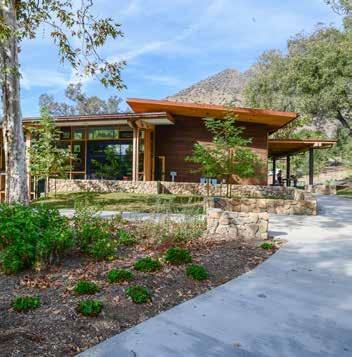
curriculum by, among other things,
some of the things our Riding and Backcountry
have taught us about how to open doors to
Our new multicultural center answers a critical need.
On the Ground
At the outset of the school year, Blossom invited us to embrace the wisdom of beginner’s mind
we aspire to do and be our
The Pergola
of noteworthy
Armchair Wandering
Thomas CdeP
Little League
of shaking
learning from
and getting back into
A report on some of the ways we’ve been able to gather and ways we hope to gather in the near future.
Class Notes, etc.
and milestones sent to us by our readers.
In Memoriam
The Best We Can Do
creative class of 1971
a creative 50th reunion
in the spirit of creativity.

Ishared these words from Rilke at our New Year’s Banquet, which at Thacher is an event that takes place in September, the eve before our first day of classes. Much like the start to the calendar year, it is a time for reflection on what’s come before and what lies ahead, a time to take stock.
On that occasion, I offered Rilke’s words as an invitation to consider what it means to start anew. We humans are drawn to the idea of beginnings, of setting off, of starting up, of a new chapter. The predictable return to starting fresh that a new school year brings is something that I love about my life and work at Thacher. Each fall, we begin again, always setting the intention of “the best year yet.”

And each year here is indeed “full of things that have never been.” When I was a senior at Thacher, serving as a prefect in Casa, our dorm head Bo Manson gathered us together on the first night in the dorm and asked us to reflect on the idea that each year at Thacher we create a community that has never existed before, that each year we are a different group of people, brought together in the shared constants of this place, its values, and our purpose. In focusing our attention on this new beginning, Mr. Manson was helping us see that community is a living entity, more of a verb than a noun, and that each of us played a critical role in caring for and shaping it.
That wisdom seemed particularly resonant this fall, as we welcomed a new year in the shadow of the report on historical sexual misconduct that the board of trustees shared with the community in June. We were at a beginning, but one which so clearly called on us to understand our past and carry it with us as we care for and design the community we need today.
On that New Year evening on the Pergola, I shared some of my reflec tions from the profound and painful preceding months. In the face of so much suffering, and uncertainty and division, of pandemic and climate change and cultural schism, I asked, how do we set the intention of “the best year yet”? When the ways we have lived and made sense of the world seem insufficient to the challenges we face, where do we turn?
I believe the idea of a beginner’s mindset may be one place to start. In one sense, the current environment has made us all beginners, living in ways we never have before. What if we embraced that fact? As a beginner, I don’t have to lament my lack of experience, it’s expected. I’m not limited by beliefs about what I can and can’t do, because I don’t yet know my limits. I am eager for the knowledge of others and my first-hand experience. I don’t have to pretend to know things I don’t or expect perfection. A beginner is oriented to learning rather than knowing, unhampered by the burdens of expectation and outcome—that is the wisdom of the beginner’s mind.
A Thacher education is in many ways a constant invitation to the begin ner’s mindset, to letting go of the expectation of comfort and certainty,

And now we welcome the new year. Full of things that have never been.
— Rainer Maria RilkeBlossom presides over annual beginnings at the New Year’s Banquet.
expertise and perfection. We say yes to horses and mountains, knowing they will strip us of the comfort of the known. We say yes to honor, fairness, kindness, and truth, knowing they will require us to take responsibility for more than ourselves, to stand for more than our individual interests. We say yes to life in a diverse community, recognizing that it will require that we step out of our understanding of the world and into that of others. We say yes to doing hard things, things we don’t yet know how to do, things for which there is no road map, because we believe they are the right things to do. We don’t come to Thacher to do the things we’re already good at. We come to learn, not so that we can be right, but because we want to be and do good.
It is this learning, growth, and adventure that I see reflected back in the pages of this issue of our magazine and in the inspirational work of our students and educators. The creation of our new Multicultural Center,
the interdisciplinary work happening in GATES, and the fresh perspectives of new community members building on the strong foundation laid by so many before us are but a few examples of the many beginnings that are propelling Thacher forward.

I am excited to share this with you, and to enter this new year recom mitted to the work ahead, rooted in the best of who we have been while aspiring to the best of who we can be. Thank you for reading, for staying engaged, for holding us up, and for holding us accountable as we work together to continue to design this one-of-a-kind community.


The Magazine of The Thacher School
Volume 14, Issue 2 Fall/Winter 2021
This page used to be reserved for letters from readers and an occasional note from the editor, but the fact is we don’t get a lot of mail these days and we’d prefer to let each issue speak for itself. So, with this issue we are introducing ICYMI (“in case you missed it” for those of us less fluent in text-speak). Here we’ll share a couple of noteworthy social media posts from recent months and remind you that the best way to stay up on day in, day out School news is to follow our social media accounts listed below. Meanwhile, we hope you what you see.
 Aimee Brown-Nelson DESIGN Michael Artman, Landesberg Design PHOTOGRAPHY
Christopher J. Land, Carin Yates
Aimee Brown-Nelson DESIGN Michael Artman, Landesberg Design PHOTOGRAPHY
Christopher J. Land, Carin Yates
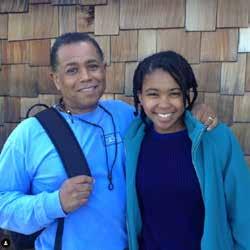
Thacher is published twice a year by The Thacher School, and is sent free of charge to alums, parents, and friends of the School. Every effort is made to ensure that contents are accurate and complete. If there is an omission or an error, please accept our apologies and notify us at the address below.
Copyright © 2022 The Thacher School

Third class postage is paid at the Oxnard Post Office.
POSTMASTER: Please send form 3579 to the following address. Editor, Thacher Magazine 5025 Thacher Road Ojai, CA 93023 thacher.org thachermagazine@thacher.org 805-640-3201 x264

How to Submit Class Notes Online: blogs.thacher.org/classnotes E-mail: alumni@thacher.org Fax: 805-646-1956 (fax)
Thacher is printed by Ventura Printing using an environmentally friendly waterless printing process, soy-based inks, and recycled paper.

Before classes, before camping, before horses, comes an opportunity for fun led by the seniors in the form of some getting-to-know-you games and a barbecue on the Upper School lawn. In addition to marking the beginning of some lifelong friendships, for many it is also a first glimpse of Ojai’s magical golden hour.
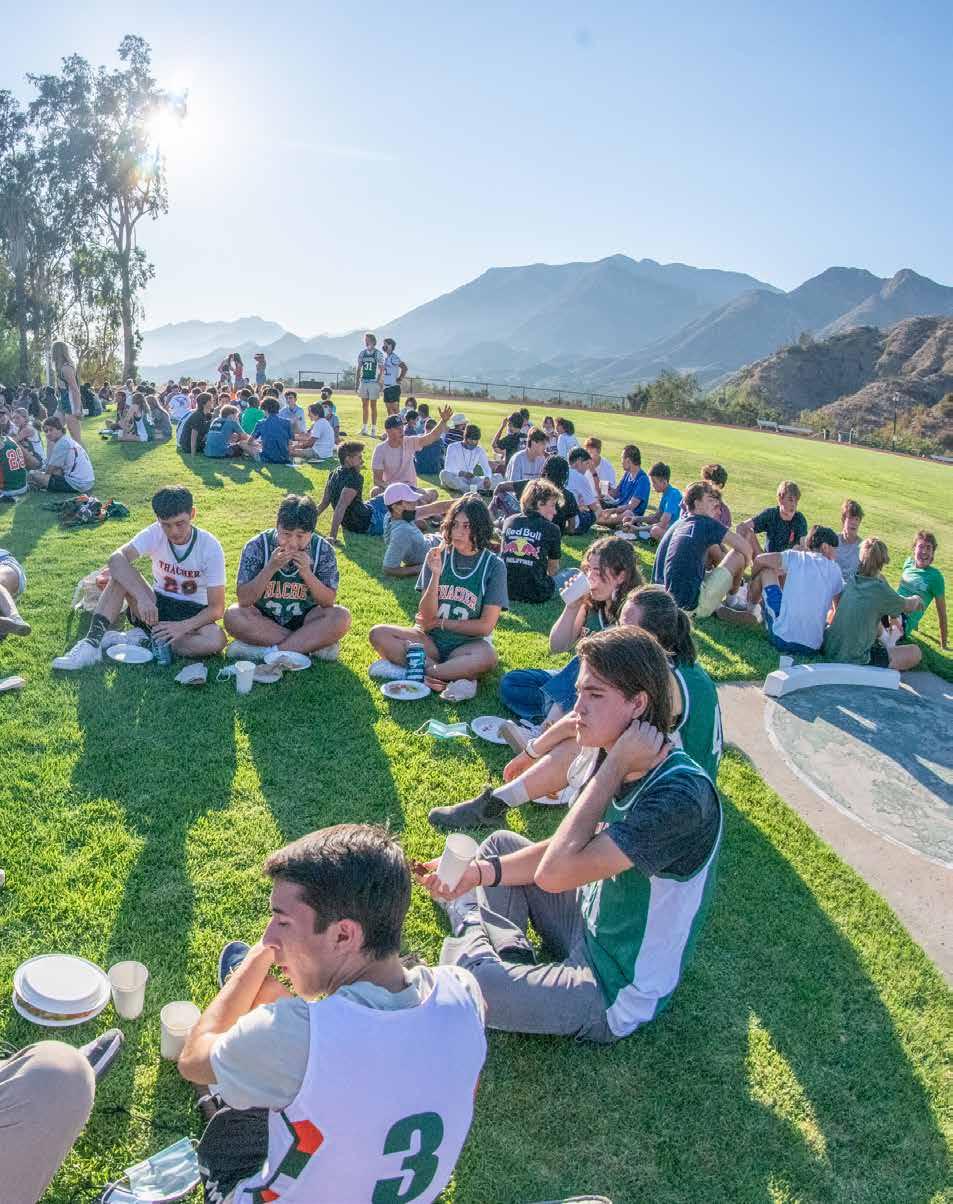
The beginning of the Thacher school year is an opportunity to both discover and develop new interests, double down on established ones, or just follow a whim for the fun of it. Nowhere was this more evident than at the annual club and activities fair held on the patio of the dining hall in October. Students staffed and strolled numerous booths promoting clubs that ran the gamut from niche (such as the clubs devoted to mushrooms, essential oils, reality TV, and single childhood), to activitybased (including clubs focused on volleyball, fishing, lacrosse, surfing, biking, pingpong, and skating), to country clubs (as in Japan, Sweden, and Korea), only to mention a few!

While our Backcountry Program was significantly impacted by covid-19 last year, we were excited to get our community back to these amazing trips. Due to fires, droughts, and closures of parks and forests, we had to reorient in favor of safer routes, taking students to the Channel Islands, Morro Bay, Point Reyes, Leo Carrillo, Big Sur, and El Capitan.

From Friday night’s Performing Arts sampler to Sunday afternoon’s riding exhibition, Fall Family Weekend was chock full of fun, family, and a thrilling football win.


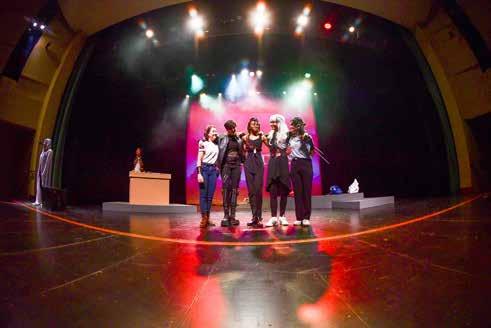
On November 5 and 6, the Thacher Masquers presented their Fall Play, She Kills Monsters by Qui Nguyen. The play tells the story of Agnes Evans, who leaves her childhood home in Ohio following the death of her teenage sister, Tilly. After Agnes finds her late sister's Dungeons and Dragons notebook, she stumbles into a journey of discovery and action-packed adventure in the imaginary world that was Tilly's refuge.
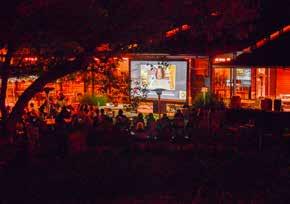



Thacher celebrated the opening of its new Wellness Center in November. Located in the former Health Center building, the Wellness Center holds offices for visiting therapists to meet with students on campus for individual sessions, as well as the opportunity for support groups to meet together in a private setting. It is also a space where students can study, socialize, listen to a meditation app, and find a moment of peace and relaxation. The Wellness Center offers activities and events such as yoga and mindfulness. In addition, Emotional Health Task Force, a group of students and faculty who are passionate about creating more opportunities for health and wellness, will help to plan fun activities and events in the space, centered around individual and com munity wellness.
The third-annual Martin Luther King Jr. Youth Leadership Summit kicked off on Sunday night with a conversation about challenges to a more inclusive democracy with voting rights activist and 2021 MacArthur Genius Fellow Desmond Meade. On Monday, Loretta J. Ross delivered a keynote address about creating call-in (as opposed to call-out) classroom communities.
With what Coach Hooper described as “excellent chemistry” and “strong senior leadership,” this year’s team developed a positive and supportive culture. The regular season concluded with one of the most memorable games in our program’s 20-year history, as we overcame a 10-point deficit with under three minutes to go to defeat Cate in front of a large Family Weekend crowd. It was an extraordinary moment that meant a lot to the players. We ended up losing in the semifinals to a tough Grace Brethren team by a score of 43-34, but that lone loss did little to dampen the joy and camaraderie that characterized this team.
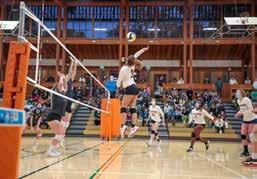
Volleyball was a big draw on campus this fall, as three indoor teams (varsity, JV, and frosh) had strong seasons. The varsity team advanced to the second round of CIF playoffs and finished the season with eight wins and six losses. Not all of the volleyball action was confined to the indoors; the sand volleyball courts installed last year offered a very popular afternoon activity.
The late-season pairing of seniors Natalie Cheng and Ami Wallmark proved to be a dream team for Thacher tennis, as the pair harnessed confidence and talent to earn the top doubles ranking of the Tri-Valley League.
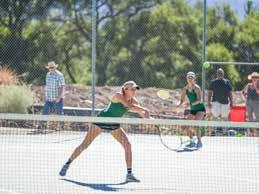
Trail Crew started off the year by creating an alternative route to the Observatory now that the main road has been paved and is thus unsafe for horses. The students labored with hand tools on many sunbaked afternoons to create a shortcut linking the Phelps trail to the Shagam trail. All accomplished with brains, brawn, and a batch of hand tools.


At the NCAA Division III Cross Country National Championship in Louisville, Kentucky, Colin Kirkpatrick CdeP 2019 made a homestretch surge that helped the Pomona-Pitzer men’s cross country team claim its second-straight NCAA title, earning himself all-American honors in the process. In the final stage of the race, the Pomona sophomore moved himself from 29th place to 10th place to set an 8k team record (24:01.8 ) and help clinch the win.

This year’s Orrick Lecture was delivered by awardwinning documentary filmmaker, Thacher parent, and trustee, Dawn Porter P ’19, ’22. After being introduced by her son, Will Graff ’22, she spoke about the powerful intersection of art and activism. Dawn’s body of work includes John Lewis: Good Trouble, an acclaimed documentary exploring late Congressman John Lewis’ pivotal role in the Civil Rights movement.
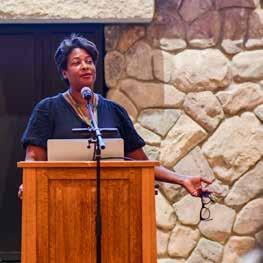


Morgan Neville CdeP 1985 recently completed Watch the Sound With Mark Ronson, a six-part docuseries (available via Apple TV+) that offers deep dives into the recording techniques and technology behind music luminaries including Paul McCartney, Questlove, King Princess, Dave Grohl, and others. Morgan was also an executive producer for Worn Stories, a recent docuseries on Netflix that makes treasured items of clothing the focal point for glimpses into the lives and loves of their owners.

Assistant Head of School Jeff Hooper wrote the forward for Capstone: Inquiry and Action at School, by Nina Leacock and Jon Calos, a recent publication by teachers for teachers that can be traced back to the EE Ford Grant Thacher received in 2012. That grant funded a Thacher-led forum, Capstone Consortium, designed to help schools develop and improve their senior capstone projects. As the inaugural director of that consortium, Jeff Hooper was a logical pick to write the forward.

By graduation the typical Thacher student racks up a couple of months sleeping in the wild, in or out of tents. Parent of alums (Carissa ’00 and Cameron ’03) and East End neighbor Rick Ridgeway begins his latest book by calculating that he’s put in more than five years of tent time. Life Lived Wild: Adventures at the Edge of the Map is a memoir that details some of his storied travels—often made in the company of other notable environmentalistadventurers including Yvon Chouinard (a fellow Thacher parent), and Doug Tompkins (a Thacher grandparent)—and how these expeditions have taught him “to distinguish matters of consequence from matters of inconsequence.”

A Backwards Glance Through the Pages of CdeP Publications
125 years ago 1896
One of the horses, affected by the atmosphere of learning about him, has acquired proficiency in undoing snaps and untying knots. When he has taught himself to tie them up again, he will be set to weaving a new tennis net.
Casa de Piedra Notes, The Ojai 3/21/1896
100 years ago 1921
Whenever Ham [G. Hamilton Hoxie CdeP 1921] goes on a camping trip, cans of sardines, jam, plum pudding, and dozens of other delicacies are sure to go too. … Ham also engineered the record disposal of food by man on the extra day camping trip. It is reported that six huge steaks were stowed away by as many persons.
Camping, El Archivero 1921
75 years ago 1946
The war is over! Although we who have lived through it in this quiet Ojai Valley cannot say we have suffered much directly, the end was not only a relief from anxieties, but also marked the beginning of a much easier time all around. From such minor worries as where the next meal was coming from, we can turn with new zest and a lighter heart to our real job of furnishing a good education for boys, and more time to figure out how this can best be done.
Headmaster's report to trustees by Anson S. Thacher, Notes 4/30/46
Hands-on learning in 1949 as Van Griggs teaches students about mechanics.

Hands-on learning in 2021 as two students assemble a project they have created on a laser printer as part of a community art project.
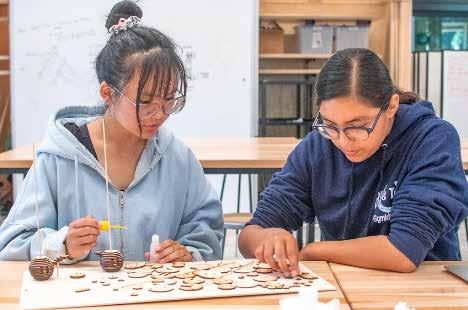
50 years ago 1971
In June of 1971, Tony Trabert, former World’s Amateur Champion and professional tennis player, inaugurated his tennis camp at Thacher. Summer Programs, The Thacher School Catalogue 1971-1972
25 years ago 1996
Although Thacher has had limited access to the internet for several years, this year every student has the chance to gain access to the limitless resources along the information super-highway…. A whole new realm of socializing has been opened up to these lucky dorms where people can, from the comfort of their rooms, chat with their friends several dorms away. (This realm has recently been suspended, though.)
“Thacher Technology Meets the 21st Century,” Notes 1/96
10 years ago 2011
I love working outdoors, and I want to be part of this community. After organizing 15 Thacher students to take part in an effort to remove invasive species from the creek near Libbey Park in downtown Ojai, Joe Bell CdeP 2012 was quoted in the Ventura County Star (11/15/10).
5 years ago 2016
Complete with a new PlaneWave CDK-700 telescope and new dome capable of being robotized, The Thacher Observatory now represents arguably the best such facility at any high school in the nation. Thacher magazine, fall 2016.
“The discomfort, the challenges, the unknown. Thacher is the place where there is much of that. A place where you will feel your most vulnerable. A place where you will feel your most pushed. And more than ever before, the challenges that we seem to face at this moment have us at our most exposed: where we are reassessing every aspect of our cul ture, our institution, and our history. There is a huge responsibility on all of you sitting here today. The responsibility of guiding our school during this critical period to mold a community where even our most marginal ized community members are “in the fold.” Where all our students feel safe, included, and supported.
But looking at this enormous challenge ahead of us, I want to remind you of a couple of things. Find the beauty in discomfort and the fun in challenge… You will face challenges, but the bonds you form here will carry you through. I know that this new year ahead is filled with unknowns. Of uncertainty. Of challenges. Not only are we at a pivotal moment in our school’s history and in that of our world’s, but the path forward is not quite clear. There is a lot of work to be done.
So, my final piece of advice to you all is: put on your helmet, pull up your boots … and enjoy the ride.”
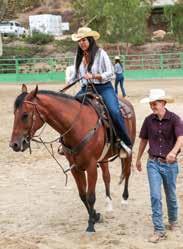

Thacher students don’t hold a monopoly on taking risks and trying new things. It stands to reason that the adults on campus would be willing to walk the talk as well. When it comes to the Horse Program, every adult working at Thacher benefits from knowing something about why we do it, what it’s like, and how humbling and intimidating it can feel to climb into the saddle for the first time … in front of your peers, to boot. That’s what’s happening in these photos from the fall, when new faculty and staff mem bers experienced the Horse Program firsthand. Horse Program Director Trinity Seely CdeP 1999 did her best to ease the nerves, but in the end, the greenhorns all had to embrace their own versions of beginner's mind and no doubt deepened their empathy for students (and steeds) in the process.
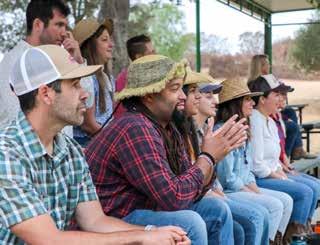
In April 2017 I decided to coach my son’s Little League team in the Minors Division. I wanted to support my son’s development in his favorite sport and thought it would be a wonderful way for me to contribute to my community. I had played baseball as a child in Gary, Indiana, and as a student at Thacher so I considered myself to be a pretty decent ball player. I assumed that I could teach a sport that I knew how to play, and I was excited about the possibilities for my son’s team with me as the coach.
During that first season, we practiced regularly, reviewed the rules of the game, and performed drills meant to enhance the players’ skills, including batting, fielding, and running. The players seemed to be having a great deal of fun and I felt good about their chances for the season. However, during our first game it became quickly apparent that I had a long way to go as a coach and so did the players. Although the players made several mistakes on the field and got very few hits, I realized that I had not focused enough on teaching pitching and catch ing and made several strategic errors concerning batting order and playing positions. Although we made improvements throughout the year, we still managed to lose every single game during that first season, and it was clear that my experi ence as a baseball player did not guarantee that I would be a good coach.
Before and during my team’s second season in the Minors Division, I decided to focus more on learning how to coach. I attended online and in-person classes and studied the game in ways that I had never done before. I became hyper focused on drills, skill-building, and techniques to help the players learn how to play all positions. Also, I improved my baseball strategies, includ ing how to build a strong batting order, and how to better position players on the field. I even solicited several other parents to volunteer as Assistant Coaches to help teach these skills and keep the players moving during practice. All of this arduous work paid off! In the second season, my team won second place in the Minors Divi sion, and we celebrated our resiliency with an end of the year banquet filled with awards for everyone.
Even though we had immense success dur ing that second season in the Minors Division and have had winning records ever since in the higher divisions—Majors and Juniors—I learned that successful coaching requires con tinuous learning, teamwork, and commitment. To get to this point I had to learn from the mis takes I made as a coach in the Minors Division and be willing to give it another shot. When my team eventually moved up to the full-sized field in the Juniors Division, we joined forces with another coach’s team, and we agreed to share the Head Coaching position. This is because I recognized early on that, although we are quite different people and have different approaches to teaching baseball, he placed great emphasis on the importance of fitness/conditioning and was a very positive motivator capable of instructing our players on the technical aspects of the game (especially pitching). It was clear that having him as a co-head coach would make our players far better than I could alone (even with the signifi cant help of my assistant coaches). Apparently the proof is in the pudding because our Juniors Division team won first place in the league in its very first season!
Reflecting on my tenure as a Little League baseball coach, it is clear that it was greatly influenced by my Thacher experience. Thacher taught me through the camping and horseback riding program to believe in myself, be willing to tackle significant new challenges and to be resil ient in the face of failure. I also learned through endless re-rewrites and retests to acknowledge mistakes, learn from them, and use them to my advantage so that I could be successful the next time. Finally, I learned the power of working together to achieve remarkable results through study groups, student-led organizations, sports, theater, and community service. I used these les sons to adapt, overcome challenges and eventu ally succeed as a baseball coach by helping to lead my team to many victories.
My coaching experience is on my mind more than ever these days as I work to fulfill my duties as a Thacher parent and as a new board member. The School is going through a time of embracing both challenges, and opportunities, learning from them, and reshaping itself to be better. It was easy for me to encourage my play ers to shake off the strikeout, the dropped ball, or the fielding error and get back in the game. However, it proved more challenging for me to step back and question my own coaching abili ties, to provide my players with the skills and tools to be able succeed, and to encourage and support a team culture around resilience and mutual support. It is something I’ve continued to work on and a role I’m happy to now play at Thacher as the School and those of us who care deeply about it refine our teamwork in an effort to help the School accomplish its goals.

Dermond Thomas is a corporate attorney, and the deputy mayor and first elected Black trustee of Valley Stream, New York. His lifelong commitment to Thacher took on a new dimension when his daughter became a member of CdeP 2024 (they will be on the same reunion cycle!). Having been appointed to Thacher’s Board of Trustees in October 2021, he is now stepping up to bat for the School in a new way.
“Although we made improvements throughout the year, we still managed to lose every single game during that first season, and it was clear that my experience as a baseball player did not guarantee that I would be a good coach.”
If there is a silver lining to this era of accelerating change, rigorous self-examination, mutating variants, disruptions of all manner, and their urgent imperative that we adapt, it is the permission that this imperative brings to try new things. It’s a spirit of openness to experimentation reflected in the attitude of our founder, and one that has come to the forefront of our work as we not only prepare our students to identify and solve the problems facing our world, but also seek to retool the School itself as an educational platform capable of anticipat ing and keeping pace with an ever-changing set of operational and educational demands. It is in this spirit of creative adapt ability that we share the following stories. You’ll read about a new building on campus that is as adaptable and flexible as the investigations it encourages, and a new multicultural space predicated on the understanding that our world is best understood through multiple perspectives. You’ll learn about the work of adults on campus helping our students develop the courage and tools to see and solve important problems, and about alums in the workforce reflecting on the challenges they see in their workplaces and communities and what they see as essential attributes in the effort to meet those challenges. What connects all of these stories is a commitment to shaping Thacher—reshaping Thacher, where needed—so that it can in turn give shape to the kind of graduates who can meet the problems we know about as well as the ones that will surely follow. Running through it all are the precious attributes of curiosity and ingenuity, commitment and humility, patience and imperfectionism that have always been at the center of a Thacher experience, but are finding new and essential expres sion here every day.

Building the courage, space, and skills to meet the challenges of an increasingly variable world
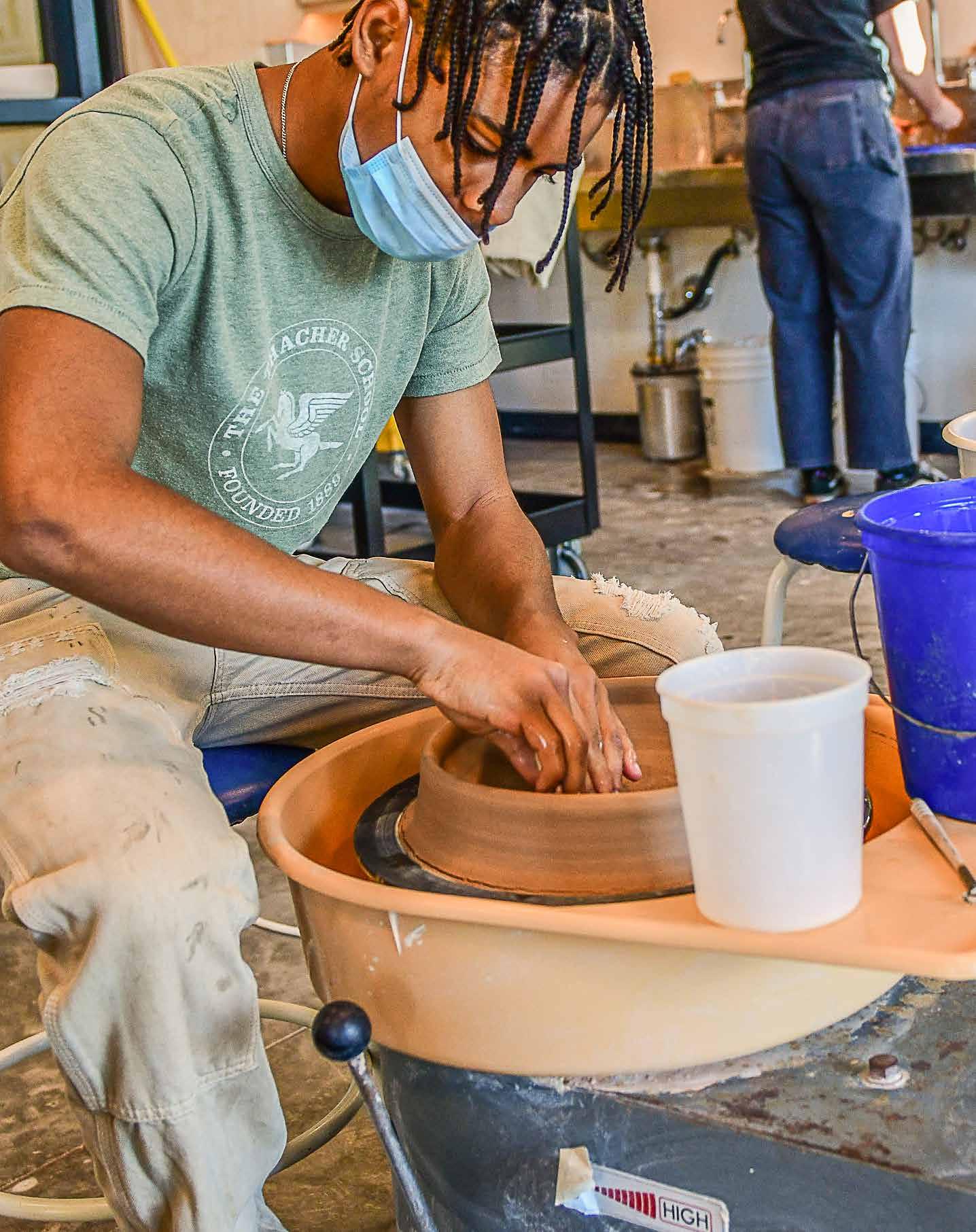
“We who try to prepare our [students] for college in a certain way are in danger of thinking no other way will produce good results. I try, however, to stop occasionally and consider whether some radically different way may not produce better results, and I think this often proves to be true.”
Thacher, Founder


Thacher’s new academic hub is at the center of academic changes that have been underway for years and are now becoming more visible. Our move away from the AP Program was an early and important step for ward, but what’s more interesting than what we left behind is where we are today and where we’re heading. As much as these changes rep resent a move away from established patterns, they also afforded the School an opportunity to better align the curriculum with longstanding approaches to learning, the kind that don’t nec essarily need a classroom but are just as likely to take hold in a barn, on a trail, on the stage, on a court, or in a dormitory common room. GATES is the most visible element of a transformed and transforming curriculum that is allowing our students to encounter new ways of discovering their interests; direct their own learning paths; and acquire the skills, knowledge, and mindsets they will need for the lives that await them after Thacher. Much of this is the result of work our faculty and administration have been doing behind the scenes—to imagine the possibilities of this new facility, to reimagine courses and teaching methods, to go back to school them selves in order to advance their craft.
What follows are some snapshots of this transformation, 13 snapshots to be exact. Why 13? We could have listed 250 ways, which is the number of Thacher students fortunate enough to make use of GATES on a daily basis, but we opted for 13, which is the number of garage doors (nine exterior and four interior), because they embody so much of what is new and essen tial about this building. More than simply design elements, these doors are central to the goals of creating connections among the disciplines, sparking curiosity, connecting the indoors with the outdoors, and rewarding attention by open ing up lines of sight and sound.

More than just ways in and out of the building, the GATES building’s 13 garage doors and the flexibility they allow create connections, free up new activities, invite curiosity, and remind everyone that class need not be confined to the classroom.
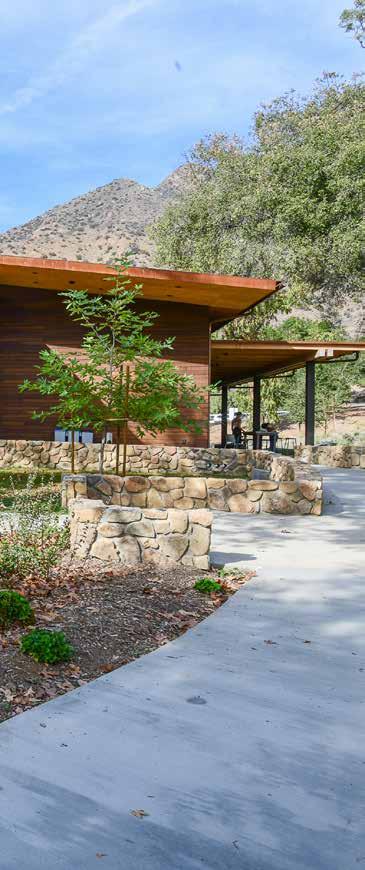

GATES is a Swiss army knife of a building that is endlessly adaptable to the purpose at hand. A stairway that’s also a class room. A fabrication space that is also an arena. A lecture hall that is also a movie theater. Move that wall, reconfigure those collaboration spaces, wheel that whiteboard! “You’ll have one building in the morning, another in the afternoon, and yet another in the evening. It is as dynamic and adaptable as the learning activities it supports,” notes Dr. Kamala Qualandar, director of programming for the facility. Dr. Spinney’s class, for ex ample, pulls a rolly board into their space each morning, collaborates on making a current events list, and then shares that by rolling it out into the hall for all to see.
3“The best part,” says Doc Qalandar, “is that students are showing us how they want the building to be used, which is what we hoped for in the first place.”



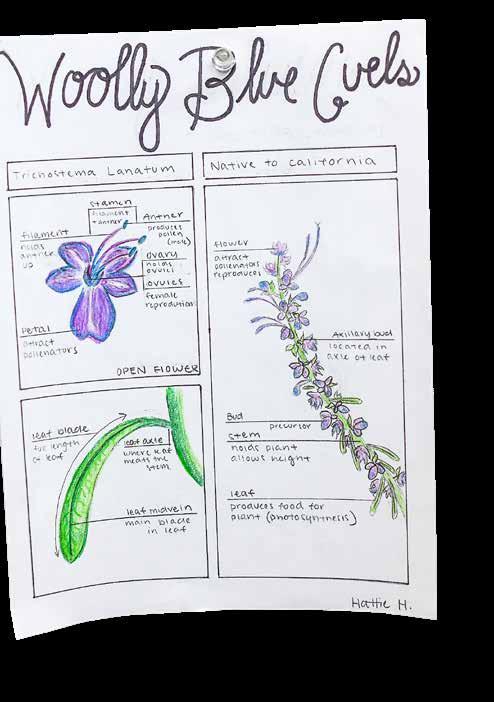

A little showing off is okay when it teaches, entertains, inspires, and piques interest. From the whiteboard retaining the hieroglyphics from yesterday's multivariable calculus class to a display case of masks made in language class as part of a writing assignment, and from student photography scrolling across the overhead digital display screens to a cluster of mysterious 3D-printed objects, the artifacts of a dynamic curriculum function as aspirational decor, inviting cross-curricular thinking, pro voking conversation and curiosity. Displayed work is not only by students; a community art show is planned for later in the year.
Ms. Pidduck has often described Thacher’s curriculum as tailored to ”adventurous minds” and nowhere on campus is that more evident than GATES. When inviting the student body to the building’s opening, Director of Studies Dr. Tracy Miller said, “Come and see all of the dangerous stuff inside.” It wasn’t the normal classroom hazards like staplers and three-hole punches she had in mind. Behind those garage doors are lasers, chop saws, arc welders, and more.
Before GATES, there was the unadorned and mostly windowless Humanities Build ing, which confined student attention to the teacher at the front of the classroom by blocking all other distractions. GATES takes the opposite approach with an open design made to invite the gaze and transmit sound. This disposition toward distraction is, as they say in the Comp Sci class, a feature, not a bug. When the teacher is the center of learning, you need to minimize com petition for attention, but when you put students at the center of their own learning, distractions lead to inspirations, aspirations, and motivations toward new ways of think ing, cross-disciplinary connections, and serendipitous juxtapositions.



Iterative design is not just some thing students learn to do in class, it’s something the faculty is con stantly doing with the curriculum itself. And though it’s not limited to the GATES building, the flexibility of that space is emblematic of a cur riculum that is constantly giving rise to innovations in an effort to improve itself. Some of our new and evolving offerings include a popular field biology course taught in part nership with our neighboring Turtle Conservancy; a veterinary medicine course that makes a learning lab of our equine herd; and an applied chemistry program that crosses over into art history by synthesiz ing ancient pigments. And new ideas arrive every term, incubated in our xBlock program that builds in opportunities for faculty to test new topics and teaching approaches and for students to suggest courses and activities they would like to see represented in the curriculum. In fact, the whole curriculum is set up to create academic pathways that allow students to foster and follow their own curiosity, to experiment with and ultimately take charge of their own learning.
7Plain old-fashioned fun.
5Virtual reality games, a student-made miniature golf course, movie night in Hearst Lecture Hall on the weekend, or an invitation to try a new artistic medium— such are the routine opportunities for simple fun that GATES supports. And be yond play as an end in itself, the building also helps our faculty incorporate many kinds of emotional engagement into their teaching approaches. Challenge Success, an offshoot of Stanford’s Graduate School of Education devoted to helping schools develop models of success that better serve their students, conducted a survey of Thacher academics in which students reported high levels of affective engage ment, meaning that they find meaning, purpose, and joy in their schoolwork. This was the case before GATES, and the new facility has only expanded options for blending rigor, purpose, and joy within and beyond academics.



GATES broadens views and connections across the curriculum and also beyond Thacher’s gates by bringing inspiring think ers, doers, artists, and teachers to campus. An important resource in that effort is the Class of 1971 Visiting Artists Program (read more about it on page 45). As GATES opened its doors last spring, its first visiting artist, Jonathan Capone, presided over a series of workshops, activities, and events. He instigated a problem solvers club for nascent inventors, mentored a team project to construct (and then play!) a miniature golf course, helped students mount a virtual reality escape room, and offered all manner of trainings on the tools and equipment in the building’s fabrication garage. As campus reopens to visitors, the School is looking for ward to welcoming its next visiting artists to share their projects, work with students, and collaborate with the faculty. On the docket are digital collage artist Cassandra C. Jones, musician Mikael Jorgensen (who plays key boards for the band Wilco), illustrator Walker Cahall CdeP 2003 (whose work appeared in the last issue of Thacher magazine), and Christopher Cantwell (a writer, director, and producer best known for his work in comic books and film).
Now the call is out to all alums to who may know (or even be!) somebody who might be our visiting artist, designer, and educator. Interested candidates should send a proposal, resume, and letter of interest to Kamala Qalandar, director of programs for technology and innovation, at kqalandar@thacher.org.

GATES was built not only to accom modate curricular ideas that didn’t fit within existing campus spaces, it was also designed to inspire and incubate continued curricular innovation, to serve as a lab for new approaches to teaching and learning at Thacher. “We said, ‘let’s make a space for experi mentation,’” explained Director of Studies Tracy Miller, “find whatever cool things emerge, say ‘yes’ to them, and see what blooms.” And what grows within this pedagogical petri dish is not limited to science or art classes. Dr. Boyd, for example has re designed the ninth grade English pro gram to include publication of a new literary magazine called Just Write “Let’s get these kids confident in their own voices and the power of their own ideas and how to share them,” said Dr. Boyd, “before we begin exposing them to Greek epics, or Shakespeare.” Read about similar innovations in the his tory department on page 32.

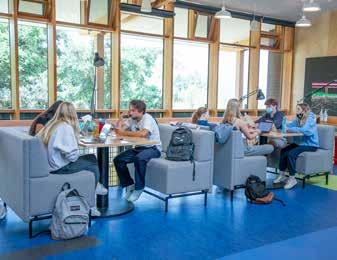

Envisioned as a venue where everybody would feel at home, GATES has proven itself to be a place where classrooms and stu dios invite lively work (and play) before, during, and after classes. But it goes beyond that. Just as camping trips, theatrical casts, and athletic teams serve as social connectors by throwing people together regardless of grade level, background, or academic interest, the same kinds of connection oc cur when small groups of students work together to explore new academic territory, harness the power of diverse perspectives, and take artistic risks.
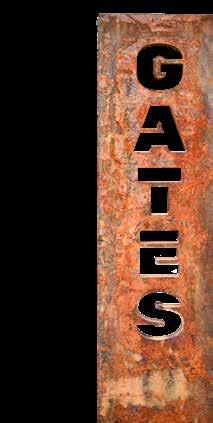

Once you set the learning free from the classroom there’s no telling where—or when—it will take place. “One of our hopes in designing this building,” says Tracy Miller, “was to create a place the kids could not stay out of.” Visit GATES after dark and you’ll see how well the design has succeeded: a small group of students here clustered around a whiteboard, a pair over there hunched over laptops polishing a multimedia presentation for tomorrow’s class, or Ms. Hooker emptying the kiln out side of the ceramics studio with the help of a few students eager to see how their glazing turned out. But it doesn’t stop there, a starlit stroll might take you past some vet med students walking back from the barns after visiting a “patient” there, or a couple of fledgling astronomers ascending Observatory Hill to capture some images of the night sky. The point is, whether the students stay in or out of GATES, learning is taking place at all hours.
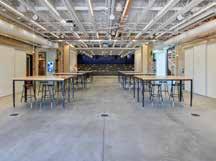



12Historically, faculty offices have been organized by department, but the Fung Faculty Center, including a cross-disciplinary lounge and meeting room, offers our teachers an adult space in close proximity to everything else that takes place in GATES. Teachers are close at hand to answer questions, provide a little extra help, see what colleagues are up to, and, most importantly, to join in the fun!
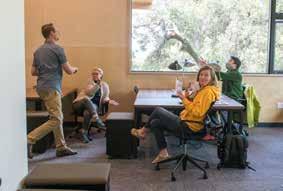
Nothing kills creativity like cleanup time. The ability to make a mess, and to leave it a mess over time as you gradually shape it into something, is critical to the creative process, whether you are designing, painting, engineering, sculpting, or whatever. And this building was designed with that in mind, with multiple specialized spaces for inspired tinkering and dynamic disorder: a fabrication garage, a physics and robotics labs, ceramics and painting studios. And most of these spaces have been designed with enough flexibility to accommodate varieties of messes we haven’t even thought of yet.
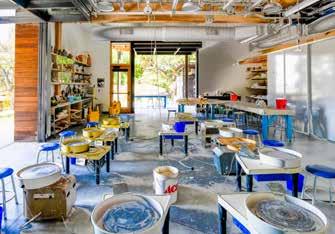
To keep up with GATES activities, follow Thacher on Instagram, where we’ll be sharing updates from time to time.

have,” said one of the heads of the Black Student Union (BSU), Lawrence Langan ’22. “A couple of years ago, I could not have imagined that I would see this in my time at Thacher. Now that it is here, it feels like a space for everybody. We had a great cross-section of the School turn out for the opening. We’ve come a long way.”
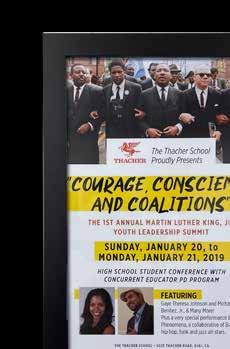
ON A FALL NIGHT IN THE HILLS BUILDING, a crowd of students and faculty gathered in the space that a year ago had been a ceramics studio, and for decades before that, Thacher’s cafeteria. On this night, however, the School was gathering for the first time in a new Multicultural Center.
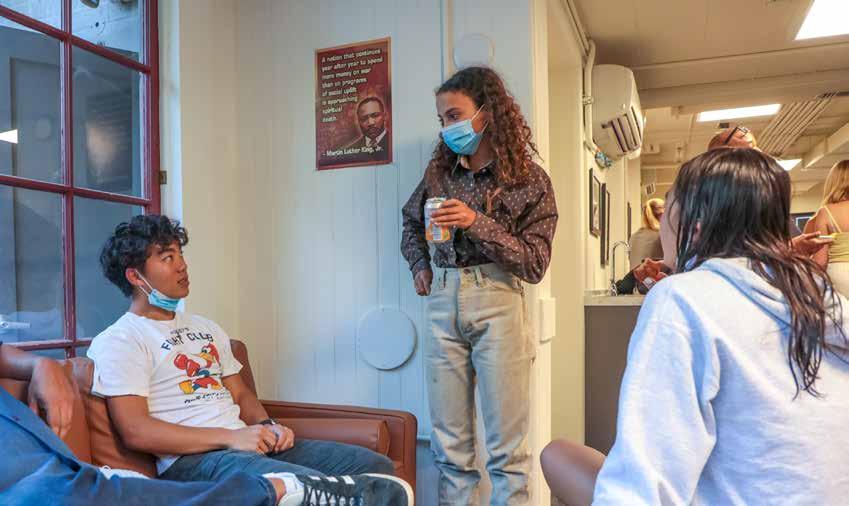
“So much of what we have been doing as a school of late is to examine our existing structures and reshape them to better align them with our values,” said Head of School Blossom Pidduck. “This space’s previous use as a ceramics studio seems especially apropos. We shape our vessels to the purpose we intend and now this space can better support the work we’re doing to support our students in being the kind of community our values call us to be.”
“This is the space we have always needed but never knew we could
The Multicultural Center comprises three rooms of various sizes and shapes designed to meet a range of needs, most of them student-driven. There is a large room for meetings of clubs, affinity groups, ally groups, or to serve as a venue for visiting speakers. There is a space set aside for team work or solitary study, and a bright and inviting lounge space for those who wish, in the words of Director of Diversity, Equity, and Inclusion Matt Balano, “to take a break and a breath.” There is also an office for Raúl Soto CdeP 2014, who assists Matt by serving as a liaison with student groups to help them develop their own goals and programing for the space.
“The Multicultural Center welcomes students and adults of all back grounds,” said Matt. “It is a space for engaging in community dialogues and to gather for club meetings, presentations, guest lectures, and film screen ings centered on culture, identity, and belonging. The lounge area provides an additional central space on campus for students to relax and connect in the midst of a busy day or during down time on weekends. Overall, the MCC functions to bring our community together in honoring, respecting and connecting across culture.”
As students and teachers mingled and chatted, a large screen displayed a series of slides, one of which read: “We need to care less about whether our children are academically gifted and more about whether they sit with the lonely kid in the cafeteria.”
The new space, a fulfillment of one of Blossom’s commitments from the summer of 2020, is one of many coordinated initiatives underway at Thacher. Members of the senior administration team and the faculty diver sity council have been following a course of study with Equity Meets Design, a consultancy that empowers organizations to identify and solve problems within their community and culture. A cohort of 18 self-selected students, including Lawrence Langan, is also completing the process.
“Instead of bringing in outside experts to tell us what to do at Thacher,” said Lawrence, “the School has helped us develop the tools we need to improve the School ourselves. In my workshop, we looked at the way physi cal spaces and structures on campus informed and supported our cultural attitudes and community priorities. I’m a Lower School prefect, so we made diagrams of the dorm and talked about how it reflected values, whether it supported or inhibited the things we find important, which spaces invite participation and inclusion, which ones didn’t.”
Other progress toward Thacher’s commitments to increasing equity and belonging can be seen in other items displayed on the wall in the Mul ticultural Center, which include posters promoting various speakers and events the School has hosted in recent years. Kicking off this year’s lineup was Anacapa Scholar Amikaeyla Gaston, a cultural arts ambassador for the U.S. Department of State and a highly sought-after performer and public speaker. Highlights of her week at Thacher included meeting with students in the Multicultural Center, addressing a Community Dinner, conducting a workshop with faculty, co-facilitating an affinity group leadership retreat, and leading an Indigenous Peoples’ Day assembly at the Outdoor Chapel.
One of the center’s main purposes is to provide a physical space for Thacher’s burgeoning affinity and ally group activities. Recent years have brought a notable upswell in interest and activities of this kind. The School now offers 11 such groups where there were only five a decade ago. The new space will also be a resource for recently-formed affinity groups supporting parents and alums when they visit campus.
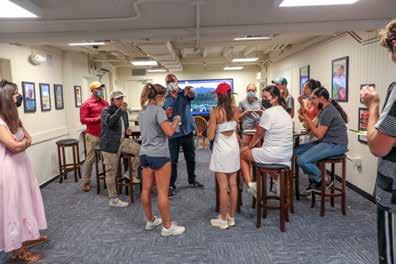
As permanent as the new space feels, it is only a temporary solution as the School mulls a more comprehensive and permanent way of housing a range of services for supporting the student body and explores options for the best use of the Hills Building. In the meantime, however, the Multicul tural Center has quickly become a key space in the day for many students.
“BSU has grown rapidly in my time here,” said Lawrence, “from fewer than 20 when I was a ninth grader to more than 40 now. We have always had spaces we could use, but they required advanced scheduling and often meant using the homes of our faculty advisors. To have this space available to us at any time has made a huge difference.”
And if the community needs instructions for using the new space, the writing is literally on the wall. One of the framed posters shares the words
Below: Posters of past community events decorate the walls of the new Multicultural Center. Lower right: Recent Anacapa Scholar Amikaeyla Gaston with Matt Balano.

of President Barack Obama: “It falls on all of us, regardless of our race or station... to work together to create a ‘new normal’ in which the legacy of bigotry and unequal treatment no longer infects our institutions or our hearts.”
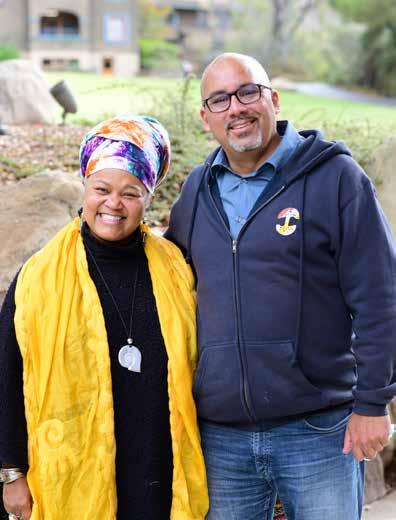
Alums on hiring and what students will need in order to play an effective role in the workplace.
What do our graduates really need to thrive in the roles their futures hold for them?
There are many ways to answer this question, one that informs every decision made about the Thacher program, but we thought it would be interesting to hear from members of the Thacher community who are involved in recruiting young people to work in their organizations. So, we asked a few Toads who think about this sort of thing to tell us what knowl edge, skills, and attributes they find most necessary in today’s world and workplace.
wo qualities that can be hard to find in job candidates: humility and patience.


As an early-stage, venture-backed company, adaptability and risk tolerance are also impor tant criteria for success. Along those lines, we look for people who have the ability to be pro ductive and thrive amongst ambiguity and rapid, constant change.
Empowering students with tools to ask the critical questions of those they interview and of teachers and mentors can help them find a good match for their own character and per sonal goals.





Also, networking and relationship building are such key skills to succeed in the workforce. We need to be offering students the opportunity to learn how to build meaningful, genuine con nections with others.
Brooke is CEO of AristaMD, a rapidly growing telehealth company in search of talented em ployees who can collaborate effectively across many disciplines.

“ We look for people who have the ability to be productive and thrive amongst ambiguity and rapid, constant change.”
T
ike many community-based non profits, we are trying to solve huge systemic problems, so we need people who come from different disciplines and backgrounds to collaborate together to make a difference. We look for people who have strong critical thinking skills, people who are extremely collaborative, people who collaborate across functions, or can themselves work across func tional areas. Of course, depending on the role, we have needs for very specific technical skills.
It’s not enough, though, just to have the requisite technical skills. We must also find people who are deeply aligned with our mission, people who have a connection to the work, and can develop a connection to the communities we serve. In other words, there has to be some kind of a passion for the work, because it is hard work and it demands an emotional investment.
We look for applicants who approach us with an attitude of “how can I help?” … people who are respectful, empathetic, humble, and looking to be of service. We look for signs of flexibility and curiosity.
It’s important to our mission, and also valuable for any organizational culture today. Most workplaces have become more inclusive and welcoming than they have ever been. More workers feel comfortable bringing more of their full selves into the workplace. And organiza tions have to adapt to that. Meanwhile, those of us who think about staff composition need
to be sure that we bring employees on board who are willing and able to work within and support this kind of a culture. People who are willing to put in the work of becoming better people and better organizations. You see this reflected in the Para Los Niños core values of excellence, constant learning, teamwork, com munity, inclusion, and trust. Recently, I’ve been making a more deliberate effort to highlight and celebrate these core values so that our staff is on the same page. That’s part of what it takes to be mission-aligned. We continue to formalize this aspect of our culture to better align our values with our performance metrics. The same metrics come to play in hiring as we seek applicants who can join us in this work of becoming a better organization. At the end of the day, what we seek is people who love their work—our work—and can bring joy to it. Are you looking to be of service? To be of joyful service? Those are the people we want and need.
Deena is the director of talent strategy and human resources at Para Los Niños. Founded on LA’s Skid Row in the 1980s, Para Los Niños sup ports the city’s underserved youth by fostering pathways to success through powerful families, strong communities, and excellence in educa tion.
The qualities we seek in recruits are curiosity, empathy, intelligence, a knack for teamwork, creativity, and a desire to solve problems. Of course there are special requirements for different job types, but since tech changes so fast, one of the most critical skills is being self-directed and able to learn. Fast.
Over the past few years I’ve really come to appreciate the power of diverse viewpoints in solving novel and complex problems. This insight has been well documented since the turn of the century, but as workplaces have evolved to be more inclusive, to be more diverse, and more meritocratic and less hierarchical—I’ve really come to a visceral appreciation of it. The other big idea that changed my thinking is the impor tance of a growth mindset and the openness to feedback. Sounds about right for someone work ing at a feedback company!




I have a tremendous amount of respect for the students that come out of Thacher. It’s obvi ous to say that the Horse Program teaches con fidence and humility and that camping improves teamwork and empathy and the ability to col laborate and problem solve with a diverse group of people. Those are really valuable and practical skills that can be put to use in a wide range of settings. If there was one to call out among the many, many positive lessons I took away from Thacher it’s this: Work hard and don’t be afraid to try something new.
Tom is CEO of Survey Monkey and considers him self “lucky to have been in the right place at the right time and to work with some of the most creative and innovative people in the world.”
“ One of the most critical skills is being self-directed and able to learn. Fast.”
With so much change in the workplace right now, people who are adapt able and able to question their own assumptions are best set up to thrive. Any part of the Thacher curriculum that can challenge students to question their own assumptions and build the skill of adaptability will prepare graduates for the needs of today’s workplace.

If we take the last two years, leaders have faced an unprecedented demand for change. Increasingly, I’ve seen leaders approaching change with a lens of opportunity, not merely as an environmental constraint. The executives I coach are shifting from “Why do we have to do this?” to “What is the opportunity this brings us? What does this offer us that we haven’t been able to do before?” Successful leaders are are able to quickly grasp that change brings opportuni ties to question our own assumptions.

In this moment, Thacher has an opportunity to embrace a comfort with change, not just as a cultural element for the institution, but also as a programmatic part of the classroom and the various experiences we give students. It could be stretching students outside of their comfort zones, asking them to assume roles they have never played, encouraging them to do things they may not think they have a lot of interest in, or simply providing opportunities to fail and try a new approach. Giving students experience navigating change and challenging their own assumptions is a critical way Thacher can pre pare students to lead in today’s environment.
Alex is an executive coach who helps leaders around the world identify and strengthen their authentic leadership styles in a diverse and changing landscape.
s an American expat living in Ecuador, I’m constantly aware that I’m stepping into somebody else’s community. As an outsider, I can never assume that I have a complete understanding of the problems the community faces, or how best to solve them. In many cases the solutions are already here; I just need to be ready to listen well enough to hear them.
People from a privileged country who travel often think that we know what is right. We have a restaurant at our hotel and I used to help with serving dishes, because I’m not a good cook. I would often visit tables to make sure everybody had what they needed. After a week or so of this, some of my colleagues on the staff asked why I was always bothering the diners. When Americans come down to Ecuador, they often complain that the service is terrible: Nobody pays attention to you, they don’t bring meals at the same time, they don’t check on your drinks.
If you want them, you have to call them. But my staff had to explain it to me and it came down to a cultural difference. Our guests at the restau rant are there for time together, my colleagues explained, it’s rude to interrupt them. The truth is, this is a time our guests have to sit at a table and not be bothered. Finally, it occurred to me that it was not about good service; my efforts to make sure they had what they wanted were interfering with what they wanted, which was time together, uninterrupted. The whole idea of sitting down for a meal in Latino culture— there’s even a word for it, “sobremesa,” upon the table, time at the table—was informed by ideas that were very culturally different than the ones I was bringing to it. This was a learning point for me; it wasn’t that the serving staff didn’t know how or didn’t care to give good service, which had been my initial outsider’s take. It was that they did care, and my understanding was off.
It’s important for Thacher graduates to rec ognize as they go out into the world that they have been given a huge privilege, having had that education, but it doesn’t mean they have all the answers.


Max is a Thacher Board member, ESL teacher, exhotelier, and director of the Latitude Foundation, based in Otavalo, Ecuador. Co-founded by Max and his wife, Latitude offers financial support to help families in the community overcome barri ers to education.
“ Change brings opportunities to question your own assumptions.”
A
“ The solutions are already here; I just need to be ready to listen well enough to hear them.”
My current project with the Chicago Police Depart ment is the creation of a 10-year strategy for organizational well ness (aka Officer Wellness). If a police officer is not doing well internally, if things aren’t going well at home, if they don't have a good support network, how are they going to manage the stress and repeated trauma they encounter on the street every day for 20-plus years?
As a trained anthropologist, I see this effort to support officers as con nected to the department's overall commitment to improving police work by evolving our organization, both through fostering cultural values and through recruiting capable candidates. As we look for recruits who are able to join that effort, we’ve branded our recruitment strategy as “Be The Change”—a strategy to identify candidates who are proactive, dependable, courageous, loyal people of integrity and sound judgment—in other words, people who embody attributes essential to successful policing today.
I also hear experienced officers tell me they wish they saw more “autonomy” in our new recruits. By this, they mean an ability to make decisions—often split-second decisions—that are guided by objective morality rather than personal feelings of the moment. That objective morality fits into what our department looks for and what our legal system looks for, whether we are engaging with a member of the public or an offender.

I can’t help but note how all of these ideas resonate with Thacher’s core values. I reflect on my daughter's Thacher experience. She arrived at Thacher with a strong sense of her own auton omy, and Thacher has allowed her to shine by celebrating, encouraging, and developing that autonomy. Some people say to me, you had this great private school education, and now you are a cop. Why? And to that I say we’re trying to
reform a system that has suffered from decades and decades of divestment—that takes courage. The sense of autonomy that Thacher fostered in me, and that I see developing in my daughter, is a lot like the autonomy, integrity, courage, and professionalism we seek in our recruits so that they too may “Be the Change.” Just as Thacher taught me to “do the best work in the world that [I] can,” Thacher continues to teach my daughter to do just that “until the best she can do is all done.”
In her 4 years working for the Chicago Police De partment, Mariposa is applying what she learned responding to 911 calls to her current work sup porting Officer Wellness. Her current project is the development and implementation of a 10-year strategy for organizational wellness to ensure that officers have the training and support they need to build resilience and manage traumarelated stress. She will complete her masters in jurisprudence in the spring.

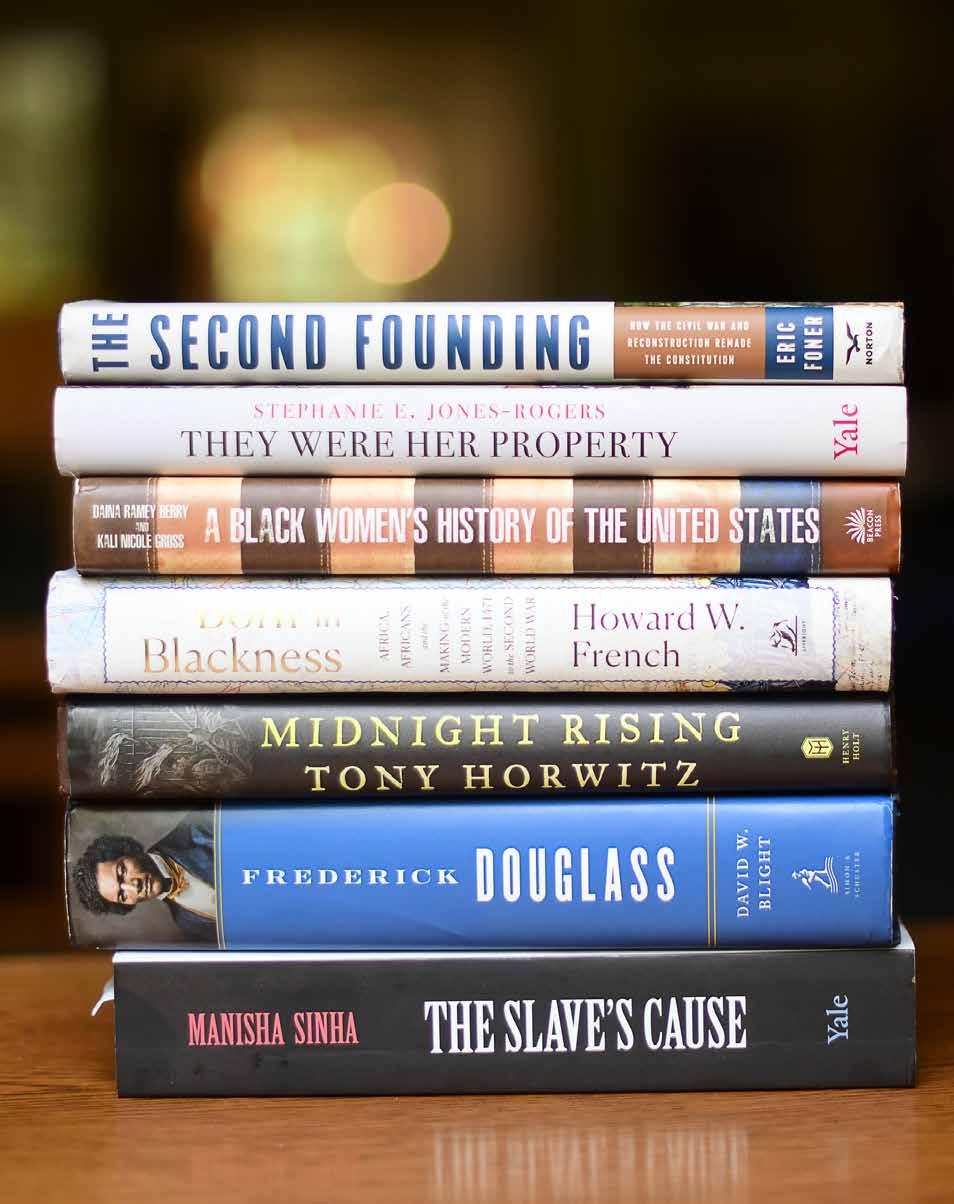
The exciting changes taking place across the Thacher curriculum are not confined to GATES. And students are not the only ones challenging themselves. Thacher faculty members are con tinuing to explore new ideas and approaches to tap into student interests, capitalize on current events, include overlooked perspectives, and take fuller advantage of all that our location and campus have to offer. Here’s what’s happening in the History Department alone.
Over the last couple of years, the department faculty has taken a critical look at the existing curriculum with an eye to, as Dr. Spinney likes to say, “opening things up.” The result has been changes designed to enrich the student experi ence, bring in more historical voices and critical perspectives, and stimulate student interest in the connections between the “real world” and what they learn in their history books. Following are a few examples.
While American history has not changed, per se, perspectives on it have become richer, more varied, and more nuanced as new scholarly work has been done in American Studies and related fields. One of our primary goals this year was to amplify and examine the perspectives of view points that had traditionally received only mini mal coverage in the traditional textbook-based recounting of American history and, in doing so, to build a more polyphonic understanding of this rich, complicated past. Thus, we rounded out the familiar narratives of American History with primary sources examining the experi ences of indigenous peoples, African Americans, Latinx, Asian Americans, women, and the work ing classes. We did this both through introducing personal diaries, speeches, and other types of firsthand accounts that capture the perspectives of a more varied selection of individuals—both famous and little known—and by engaging with a more diverse set of scholarly works including
historiographical writings by W.E.B. Dubois, Ronald Takaki, Eric Foner, Paul Ortiz, and Rox anne Dunbar-Ortiz. In addition to argumenta tive research essays, students periodically had options to produce short films, podcasts, graphic novels, and multimedia story maps, to offer the potential for a dynamic reader experience and greater student engagement both with their own work and each other’s.
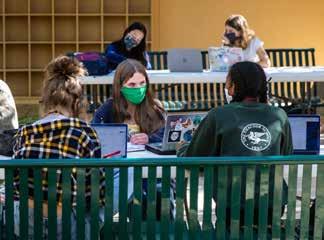
Ninth-grade history, taught by Drs. DelVecchio, Spinney, and Greene, also made moves away from traditional textbooks to draw on more recent dynamic scholarship from authors such as Charles Mann and Jeffrey Sachs. Students were invited to explore, research, and present to their peers about the important contributions of an ancient civilization of their choosing. Through a series of essays, posters, and presentations, the class went on to explore and make sense of the ways that today’s interconnected and diverse global landscape has been shaped over centuries by the cultivation and extraction of commodi ties (such as cacao, sugar, cotton, gold, silver), industrialization, economic trade, patterns of oppression, and powerful resistance movements.
In his Honors Contemporary Ethics course, Jason Carney combined student-led research about contemporary challenges faced in America in connection to education, policing and the judi cial system, and access to healthcare resources with opportunities for community education and activism. Working with student feedback and interest in engaging with many powerful recent events that have shaped American life, ranging from the coronavirus pandemic to pro tests against police violence, Mr. Carney and his students decided to investigate various areas where vast disparities in access to resources had become glaringly clear: policing, the criminal justice system, healthcare access, and education. As one student wrote in their end-of-project reflection, “Oftentimes, the school curriculum is a little distant from real world problems and something I took away from this project is that there's a way to make our learning matter and make a tangible difference. The stats we read on
the difference in education depending on race, class, wealth... were stunning and confirmed what we thought as well as prompted more questions about our nation's education system.”
Dr. Spinney has been doing much work in the area of indigenous studies and partnering with faculty in other areas, including the sustain ability program and the science department, to build our knowledge of indigenous cultures, such as the Chumash, whose histories are deeply interwoven with that of the Ojai Valley. He has also been working to develop digital showcases for student work in GATES and around campus as well as creating The Thacher Review, a studentcurated and peer-reviewed online website show casing student work in Honors US History.
Dr. Greene has taken the pandemic as a cue to develop a course on the history of global health, a focus of her doctoral research, from the era of colonial medicine to the present.
The department’s newest member, Jake Conway, brings a wealth of experience having taught American students in Beijing as well as in inde pendent schools on the East Coast. This fall, he offered Middle Eastern history and economics.
Alumni families returned to campus for Fall Family Weekend for the first time since 2019!

CdeP 1971 classmates, Paul Gavin, Phil Murphy, and Hans Peter Nielson, returned to Thacher for a tour of the new GATES building. The Class of 1971 created the Visiting Artist Program, that welcomes artists, designers, and educators to work collaboratively with students and teachers in the GATES, a building devoted to creativity, technology, and educational experiences at the intersection of disciplines. Read more about this gift on page 45.
Please visit Thacher when you are in Ojai and have spare time! Contact the Alumni and Development Office to plan your visit ... or just come on by.

KEEP AN EYE OUT FOR ALUMNI EVENTS coming to you this Spring and Summer! With covid-19 still being an ever present risk, we are looking for alumni to volunteer as hosts for small gatherings around the country. If you are interested in host ing or co-hosting a small event, reach out to Chanelle Walker at cwalker@thacher.org.
WE ARE LOOKING FORWARD to safely welcoming all alumni who graduated at least five years ago (CdeP 2017 and older) back to the Ojai Valley. This coming June 17-19, join us in reminiscing on the Putting Green, hiking Twin Peaks, visiting the Thacher horses, and reconnecting with classmates. Register today at www.thacher.org/reunion and plan your trip back home!

WE WERE OVERJOYED to welcome the Class of 2020 back to Thacher this past August 2021, so that we could celebrate their pandemic graduation safely. Toads were able to enjoy a Thacher camping trip at the Pata family's Lompoc ranch the night before their commencement ceremony and, after walking the graduation stage, celebrated by dancing with family and friends under the starry sky.
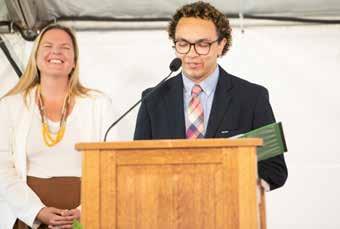

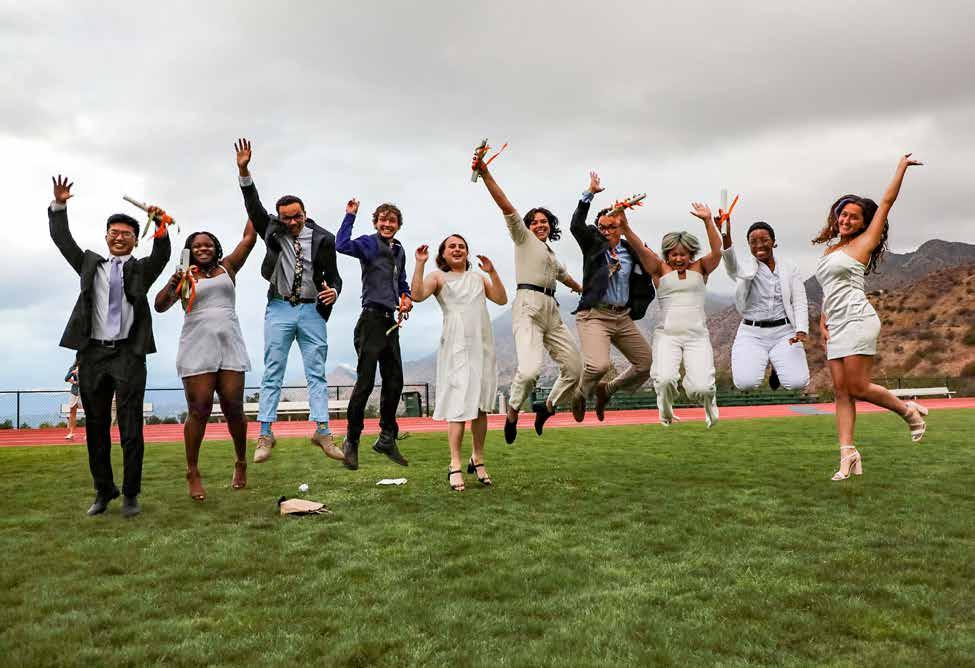

“As we '46ers dwindle in number and energy, I continue to "chop" life (as they say in West Africa!)! A young wife and two things I practiced at Thacher (tennis and cello) all demand my love and attention. A chance to write about my life's work in maternal and child health worldwide, came along from the Oxford University Research Encyclopedia of Global Health...hope it makes the final cut! Might attend the spring Reunion if JOE GLASGOW and/or other classmates can make it!

1948 CHARLTON LEWIS shares, “I live at Meadow Ridge, a senior retirement place in Redding, CT. For the last 17 years I have spent much of my time with my beloved partner, Roxane Witke, whom I met when we were grad students in Chinese history at Berkeley in 1964. She lives in nearby Wilton. I spent my career as a China historian on the faculty of Brooklyn College (CUNY). My two years as a naval officer in the Pacific aroused my interest in Asia. When I was studying at UC Berkeley in the '50s and '60s, we couldn't go to China, so I spent three years in Taiwan and Japan, studying language and researching a thesis. Later, I traveled widely in China and in 1995 had a semester as a research scholar at Hunan University. I retired in 2000 and then spent five years teaching at The New School in NYC. More recently I have studied and written on the water crisis in China. It has been an exotic career, which I have loved. Just as important was my marriage to Priscilla Allen, the widow of my Thacher classmate HARRY ALLEN and first real love of my life. We raised two daughters before her death from breast cancer in 1991. Thacher seems far away, but is indelible in my memory. I am proud of my school. I relish hearing news of its progress and the lives of my classmates.” SAM WRIGHT reports: “Our classmates all were deeply saddened by the loss of our good friend and classmate PETER DUNNE III. Peter’s Memorial,
written by his son PETER IV ’81, is in this same issue and speaks eloquently of his father. I would add only to that that Peter and I, in addition to being soccer and track teammates, shared a common interest in singing and were not only the two basses in the Glee Club but also in Los Trobadores, the double quartet led by Van Griggs, a former Whifenpoof at Yale. Further, when the Ojai Presbyterian church lacked basses, Peter and I were “volunteered” by the school and sang Sundays with their choir, sandwiched between sopranos of Wagnerian proportions. Peter was our Happy Warrior and sorely missed.” Linda and SID LIEBES spent the day at the Wright home in the foothills above Watsonville, (designed by SANDY WALKER) and wrote “having sold our Atherton, Calif., home of 53 years have quickly settled into our new abode in the nearby Sequoias retirement community in Portola Valley amid its gorgeous redwood forests and earthquake faults. We had a grand catch-up visit with Sam Wright at his remarkable country property.” SANDY WALKER, mastering minor physical issues, soldiers on after 60-plus years with his acclaimed architectural practice in San Francisco. JOHN BISSELL, who celebrates a variety of issues (including his
Moderna booster and flu shot), is happy to report that he is hale and hearty, that the fishing off his pier at Boca Grande, Fla., is as good as ever, and that he was thrilled by the election results in Virginia and the implicit rebuke of CRT. SAM WRIGHT reminds his classmates, “Please write and often. As our group dwindles your news becomes increasingly important.”

1952* JOHN VAN NORTWICK updates, “Happy to report Sonja and I are still vertical at 83 and 88 years, and will celebrate 61 years of wedded bliss in December. Hope to get to Ojai sometime soon. Semper Fi.”
1959 CHRIS HENZE shares, “My memoir can be read at adst.org under Oral Histories collected by the Association for Diplomatic Studies and Training.”
1962* In November 2021, ROGER IGNON, Jackie Ignon, and DON PORTER held the 4th Annual Gui Ignon Memorial exhibition for student and emerging artists at Create Center for the Arts in Palm Desert, Calif. Don and two other professional artists judged the works of artists


aged 6 - 40 and knew GUI M. IGNON 1 was smiling down on it all, knowing he too had encouraged young artists to pursue their artistic dreams. “I know I would not be a successful artist today if it were not for my art teacher, Gui Ignon, at Thacher,” Don says. The Ignons believe that art is at the core of humanity and, as Roger said, “We want to encourage young artists to develop their skills and individual visions so that art can flourish in the community. We are very pleased to support this endeavor.”
1965 BRUCE PETERS 2 updates, “ We moved back to Altadena in Southern California. My wife, Li, will retire from teaching as a full professor next June. I hope to make it to the June celebration at Thacher. Grandchild no. 1, Aiden, has made the scene!

BOB KENDIG, DENEYS PURCELL, HARVEY KASLOW 3 all CdeP 1967 at Iceberg Lake, Sierra High Route.
1971 ADAM ENGLUND shares, “MADDIE McMORROW ’13 and Willie McMorrow rented an AirBnB next door to us in Encinitas. They spotted

my Thacher sweatshirt. My wife Victoria and I had a wonderful dinner with them and swapped Thacher stories. Good people!”
1974 WILLIAM RUBENSTEIN 4 shares, “This July, in tribute to the creature who inspired my love of big cats, and guarded by a heavily armed Kenyan Ranger, a guide and I set out to locate the grave of Elsa the Lioness, hidden in a remote forest notorious for Somali banditry. We powered our 4x4 through quicksand, routed pastoralists illegally grazing camels, and became three of the handful of people in the past decade to stand in that peaceful clearing where Elsa and Joy Adamson gave birth to the modern conservation movement in East Africa. Later, my cheetah friend and I celebrated in South Africa.”


1976 JOSH ROSENBLATT 5 shares, “Both Kate and I retired in the spring of 2021 and are loving the extra time together. Our younger daughter Ali and her husband Jhonattan have settled in Springfield, Mass., near us with their new daughter Jade (born July '20) while our older daughter Sarah and her husband Joe are still loving New York City.”
1977* ANDREW HOLMAN shares, “Looking forward to an in-person reunion this year. It will be 5 years since I spoke about stress and the immune system and found a host of Toads to help bring Seattle start-up Inmedix and its next-gen, high-fidelity, heart rate variability (HRV) stress assessments through the FDA and into clinical medicine. Medicine is about to receive a profound upgrade. https://vimeo.com/419670749”
1978 GRANT FLETCHER 6 says, “Hope this finds my classmates well … Busy year. Changed homes after 30 years. Keeping up with adult kids, jobs, graduations, and recent loss of one of my brothers. Ready for a more rational, normal year. How about you?”
1980 DAVID BUDLONG updates, “In November of 2020, my now fiancé Lester and I picked up roots and moved to the maternal family farm in Hollywood … Alabama. Enjoying semi-retirement with the love of my life in a beautiful serene setting. To wake in the morning to birds singing and not freeways humming did not take long to get used to. Being able to see the universe beyond in the somber evenings is majestical. I proposed to Lester on our way back home after a visit to California with our three dogs, Foxi, Goldi, and Bozli in our 24-foot Class A motorhome, Priscilla. We have not set a date yet, but it will be a quiet family wedding here in Alabama. Life is good today!”
1981 CAROL McCONNELL 7 shares, “My husband and I were hiking today in Santa Cruz Mountains Redwood State Park, and we bumped into an EDT. What a delight to visit with Thacher students and teachers for 10 minutes under a beautiful 1000-year-old-plus redwood tree.”
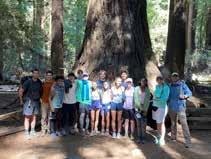
MARY BOURKE 8 updates that she “and her husband Anthony moved full-time to Park City, Utah. Look us up if you’re in the area!”
1983 KATIE BALLOU CALHOUN shares, “Calhoun update! Katie is kicking off 19 years of her PR agency, Calhoun & Company Communications, which in 2021 was listed among the Top 10 Wine PR Agencies in the US. (Yes, there are more than 10 wine agencies in the US!!)

left his 30-year commercial real estate appraisal career and earned his master’s degree in early childhood education while teaching third Grade at Town School for Boys in San Francisco. Walker (25) has been teaching outdoor science at Town School for Boys, using the Presidio National Park in San Francisco as his classroom for the past two years. Natalie (27) is finishing her double Masters at USF in spring 2022 with a MBA + MS in environmental management and she is engaged! We were lucky to have our family healthy and employed during covid, also all living in San Francisco and in the pod.”
1986 SARAH O’BRIEN shares, “TOM HALE created an awesome SurveyMonkey trivia quiz about our mystery guest for the Virtual Reunion Kickoff in December. We were honored to have FRED COLEMAN join our zoom gathering (hosted by Tom) with over 20 members of CdeP 1986 in attendance! DAN KLEIN followed up by moderating a hilariously fun and engaging fourhour Virtual Reunion in June. SARAH LAVENDER SMITH organized the event that also had an amazing turnout! The Fall Family Weekend Riding Exhibition group "The eight Amigos'' had three offspring from the Class of 1986! My son, Pierce ’25, PAUL BRESSIE’s daughter, Julia ’25, and KATE TWITCHELL MASON’s 10 son, Cole ’25 who all rode together in the mini gymkhana event. Please see the photo of them standing on their horses!”
1994 RIKA HOWE TOLL shares, “We are still in Oklahoma as NATE enters his third year teaching physics and I enter my sixth year as an elementary teacher. We are both at Heritage Hall. Our girls Adelaide (15) and Josephine (13) keep us exhausted as we try to parent with purpose and laughter during these strange times.”
1996 KORZU TAPLIN shares, “We visited the baby’s grandparents and great grandmother on the maternal side in Berkeley for 3 weeks. He took his first college tour for his 7th-monthiversary at UC Berkeley and had a home disco party—just us. Fall 2021 was FredOcean’s first time meeting his paternal grandmother, aunts, uncles, and several cousins since travel restrictions and recommendations kept us all apart. This will be

my first time in France. Celebrating FredOcean’s 8th-monthiversary in Paris or if lucky on the French Riviera. In December, we traveled to Douala, Cameroon. FredOcean Jallah Tokoto will visit his grandfather’s “Fred Tokoto” tomb and experience native traditional ceremonies and celebrate his 10th-monthiversary. We will visit the land of the pygmies and stay a few days in the beach town of Kribi, where his dad is purchasing land for future vacation stay developments.”
JAIME KELLOGG shares, “It was so wonderful finding time to catch up with ERICA WILLIAMS 11 in Beaver Creek the other day after she crushed her running race! The laughter and smiles made my day.”

1999 MICHAELA ANDREWS 12 announces,
“On October 5, 2020, Jan and I grew from a family of three (with 1.5 year-old daughter Ellie) to a family of five, welcoming our twins, Leonie Emilia (Lilly) and Finneas Henrik (Finn) into the world. We are completely smitten and also utterly exhausted! The last nine months have been very challenging, with almost no support due to the pandemic, but everyone is healthy, happy, growing, and learning new things every day. We have never felt so empty and so full all at once!”
2002*
CLAIRE MILLIGAN updates, “During lockdown I took the plunge as an entrepreneur
to co-found Aimably. I’m honored to count many Thacher Toads as angel investors already, and am thrilled to announce that we are headquartered in Ventura County. Jess and I plan to move down from San Francisco between school years and are looking forward to reconnecting with the community.”
2004 CHRIS EATON 13 has partnered up with fellow Toad JACK SLIGH ’11 for his second short film, “Dance Card's Full,” which premiered at the Ojai Film Festival in November 2021 in the Gold Coast Filmmakers Series. They will be partnering up again for the animated short film, "Driftwood," currently in production and heading out to festivals in 2022.
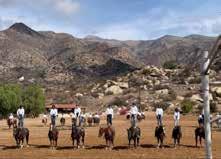

2007* ANNA TEAGUE updates, “Finally done with my training, I am back in California working as a Neuropsychologist and Clinical Assistant Professor at Stanford. I live on the Peninsula with my partner, Sam, and our spotted puppy, Charlie.”
2019 COLIN KIRKPATRICK 14 and six of his Pomona-Pitzer teammates established themselves as NCAA Division III National Champions in their incredible cross-country race last November 2021. Colin led the team to victory with his tenth place finish. Their win earned All-American status for Colin and five other team members.

Kellam de Forest died in Santa Barbara on January 19, 2021 from complications of covid-19. Kellam attended The Thacher School, and, after a year serving his country stateside during WWII, graduated from Yale University in 1949. El Archivero described him as “one of the most amiable of our class … famous for the cheerful way in which he takes a kidding” and his “unbounded gourmet's appetite.” He moved to Los Angeles in 1952 and established an independent business conducting legal and historic research for the nascent television industry. Over the next four decades, Kellam became known for his firm, de Forest Research, which contributed to hundreds of motion pictures and thousands of television episodes. A TV Guide profile once named him "Hollywood's Answer Man." After Kellam retired in 1992, he returned to Santa Barbara, where he devoted the rest of his long life as a tireless advocate for preserving his beloved hometown's distinctive beauty and cultural heritage. Kellam was known and loved for his sharp, inquisitive mind, his exceptional memory, and his dogged research skills, as well as for his gentle dignity. Predeceased by his loving wife of 60 years, Margaret (Peggy) MacCormick, his son; brother Lockwood de Forest IV CdeP 1953; and father, Lockwood de Forest Jr. CdeP 1916; he will be sadly missed by his three children, Ann, Carmaig CdeP 1975, and Elizabeth de Forest, their spouses, six grandchildren, and a great-grandchild.
Michael David Martin of Golden, Colorado, passed away on October 25, 2021. We were notified of his passing by his daughter, Megan, who shared Mike's fond memories of Thacher and especially of his horse Humuhumunukunukuapua`a, "humu" for short.

Peter Francis Dunne III of Burlingame, California, died peacefully at home on October 13, 2021. Peter was the son of Arthur Bergin Dunne and Elizabeth MacArthur Dunne of San Francisco. His siblings included: Bergin Dunne CdeP 1942, Elizabeth “Betsy” Skewes-Cox, and Robert MacArthur Dunne CdeP 1955. Peter was a

proud fourth generation San Franciscan, matriculating from Grant Grammar School before arriving at the gates of Casa de Piedra. He was followed to Thacher by his younger brother Robert CdeP 1955, nephew Michael CdeP 1974, son Peter CdeP 1981, and grandson Ian CdeP 2020. Peter continued to Menlo College, later graduating from UC Berkeley in 1957 with a B.S. in electrical engineering and computer science, after serving several years in the Navy during the Korean War. While at Thacher, Peter gravitated to the sports, winning the 1948 Spaulding Tennis Cup as tennis captain, and the 1948 Heffelfinger Track Shield as team captain, while also playing soccer and baseball. Tending to his studies, he received commendations in trigonometry, Spanish, physics, and surveying. Thacher classmates remember him as a warm, brilliant, wonderful person, with a gentle soul and a characteristic “go along and get along” nice guy personality.
Throughout his schooling, he made life-long friends, staying in touch with many of his fellow Toads. Peter particularly enjoyed attending the long-standing annual Christmas luncheon put on by the Do Nothing But Have Christmas Lunch Club, a multi-generational gathering of fellow San Francisco Toads. Peter’s last visit to Casa de Piedra was for his 70th reunion, where he was able to celebrate as part of three generations of Dunne Toads. Predeceased by brother Arthur B. Dunne Jr CdeP 1942, Peter is survived by his three children: Elizabeth “Betsy”, Peter CdeP 1981 and Samantha; his grandson Ian MacArthur Dunne; his brother Robert; and numerous Dunne and Skewes-Cox nephews and nieces.
Eric Bernard Dohrmann of Las Vegas, Nevada, passed away on October 1, 2021. He was predeceased by his brother, Bruce P. Dohrmann CdeP 1947.
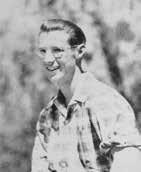

Miles Carlisle of Chevy Chase, Maryland died on January 13, 2021. Born in San Francisco, he received his undergraduate degree in 1954 from Stanford University. El Archivero notes that his nickname, Smiles, “gives the biggest single clue to his personality.” He served two years in the US Army before earning an MBA in 1958 from the Wharton School of Business. Miles worked in investment finance at Loomis Sayles, first in Boston and then Washington D.C. He continued
his career at the International Finance Corporation, where he worked in international banking for over 20 years. He never missed a chance for outdoor sports, camaraderie, and adventure. He often shared memories with family and friends about his bi-coastal adventures, most notably stories of flying his small plane during the 50's and 60's. Miles married Margo Duer Black in 1961, and they raised their two children in Washington, DC until Margo died in 2006. In 2010, Miles married Kate Dawson Clark; they lived together in Chevy Chase, Maryland, and spent their summer months on Nantucket Island. Miles will be remembered for his intelligence, kindness, and humor. He was an authoritative and humorous raconteur, an accomplished racquet sports player, and an avid bridge player. A loyal and devoted friend, Miles was a member of many social organizations and an informal group of friends he called the "Bar Trash" at the Chevy Chase Club. Miles is survived by his wife Kate Clark and his children Mary, Hamilton, and Tristram Carlisle, his 4 grandchildren and nephew. Miles was predeceased by his first wife, Margo Duer Black Carlisle and his older brother Henry C. Carlisle, Jr CdeP 1944.
George Granville Montgomery, Jr., passed away peacefully at home in San Francisco on December 1, 2020. A fourth-generation Californian, George was born in San Francisco and grew up in Hillsborough, California. After Thacher, he earned a BA from Yale College in 1955, later serving as an officer on the USS Kearsarge, an aircraft carrier based in the Pacific. He went on to attend Harvard Graduate School of Business, where he received his MBA in 1959. George's investment banking career spanned more than 50 years, starting in New York and finishing in San Francisco. He joined White Weld & Co. in 1961 and was a partner there from 1963 to 1978. He then moved to Blyth, Eastman, Dillon, and in 1981 he opened the New York office for Hambrecht & Quist. In 1995, he returned to California and held senior roles at Hambrecht & Quist and then J.P. Morgan before helping to build Seven Hills, a boutique investment bank he joined at its inception. George also served on several corporate boards, including Information Resources, Inc. and Berlex, the US subsidiary of Schering AG. He retired at age 85.George also was deeply committed to philanthropic activities, particularly environmental
causes and education. During his high school years at Thacher, where he took long rides in the hills with his horse, Papoose, George developed a passion for and devotion to the environment. In 1981, George joined the board of the Environmental Defense Fund, where he served as Chair from 1990 to 1997 and remained an engaged Trustee Emeritus until his death. From 2002 until 2011, George served on the board of the California Academy of Sciences in San Francisco's Golden Gate Park and helped lead a transformative $400 million capital campaign there. He also served as Trustee at The Thacher School (1967-1976) and at The Buckley School in New York. George was equally known for a sly sense of humor; a voracious appetite for the written word, especially on matters of history and politics; his competitiveness in any sport, particularly golf, tennis, squash, and cycling; and a meticulous attention to detail, none too small. George is survived by his wife, Nancy Miller Adler Montgomery, his sisters, Anne Montgomery Westerfield and Claudine Montgomery Brown; three of his children, George, Jonathan, and Diana; two stepchildren, Sabrina and Roman Adler; numerous grandchildren, nieces and nephews, (including Charles M. Edwards ’22; grandson Nicholas M. Edwards CdeP 2018; granddaughters Catherine S. Raisin ’21 and Margot M. Edwards ’25) and two great grandchildren. George lost his first wife, Elinor White Montgomery, to breast cancer in 1992, and a daughter, Sasha, who died of leukemia in 1970.
Donald Chesbrough Bell, Jr. passed away January 31, 2021, surrounded by family at his home on the Broad River outside Rutherfordton, N.C. Born in Cleveland, Ohio, on March 11, 1935, he spent his childhood in Ojai, attending Thacher as a day student. After graduating, he matriculated at Occidental College, where he played water polo. Later, he earned an MA in education from Western Carolina University. After serving as an artilleryman in the US Marine Corps prior, he returned to stateside in 1962 married Ruth Dickerson of Rutherfordton. They soon after bought a farmhouse outside Rutherfordton and spent the next 40 years making it into a beloved home for their family. Donald taught over 25 years in the Rutherford County Schools. He will be remembered for reading children’s classics out loud, mini-Olympics, micro-economies, theater


productions, and walking field trips all over Rutherfordton. He also drove a school bus, raised cattle, and for many years managed the Dickerson family farm.

Donald loved the outdoors and physical activity. He was a lifelong swimmer and tennis player and enjoyed hiking, horseback riding, sailing, and bicycling. He participated in community theater, built houses with Habitat for Humanity, and could often be seen picking up trash along the roadside. He was a lover of books, learning, music, animals, gatherings of friends, desserts of all kinds, and a good laugh. After Ruth’s death in 2003, Donald married Jane Alexander, with whom he had many worldly adventures.
Donald is survived by his loving wife Jane Alexander Bell, sister Ellen Bell Nachtrieb, children Alexander Bell, Dr. Keturah Bell, Sarah Bell Earley, and seven grandchildren.
Clarence Cooke "Keni" Kent died peacefully on September 29, 2021 at home with his wife, Carole. His body just wore out after a lifetime of service and engagement. Born in Kentfield, California, Keni grew up in Kentfield, the Ojai Valley, and Washington D.C. A superlative teacher and lifelong learner, Keni’s irrepressible curiosity inspired everyone he met. He was educated at a series of excellent schools; including Thacher. His dedication to service, friendship, and care among the world's most vulnerable began with a stint of service with the Quakers in Mexico while a student at Antioch. In 1958 he married Margaret Neal Strohbehn. Keni's work with the humanitarian aid organizations CARE and the Peace Corps took them around the world from 1958 to 1967, where his incredible linguistic skills (fluency in three languages and six more with limits) helped him make a lasting impact. Back in the U.S., Keni followed his interest in politics and solar energy, before discovering his calling as a teacher. He taught generations of students, holding a special fondness for those students most alienated from the joys of learning, or shut out of higher education by the many obstacles they encountered. In 1992 he married Carole Kelly at their home in Napa, where they built a life together at the heart of many communities. Together they created their beloved Wombats' Farm, filled with organic vegetables, flower
gardens, an olive grove, and a vineyard. They loved to travel and were fortunate enough to be the exchange professors in Tasmania Australia. Keni is survived by his wife Carole, his children Roger and Eliza, his two sisters, Molly Schardt and Alice Stephens, five nephews, and five grandchildren. He was predeceased by an infant daughter and a young daughter, Shannon, as well as his wife's daughter Aine Kelly.
Rear Admiral Stewart Andrew Ring, USN (retired) of Waialua, Hawai’i, passed away peacefully in his sleep on July 17, 2021, from heart disease. He was 87. Stewart was born to a navy family in Coronado, California, in 1933. He had a distinguished 32-year naval career, with deployments to the Pacific then diplomatic and recruiting assignments to NATO, Council of Foreign Relations, the Pentagon, and Oahu’s Camp Smith, where he served as Director for Plans and Policy for the Pacific Command. He received numerous awards for superlative service. In November 2020, he was honored to be included in the Coronado Avenue of Heroes. After retiring in 1987, Stewart volunteered in his community to “preserve and protect Oahu’s North Shore” from overdevelopment and “keep the North Shore country.” He adored his family, friends, and Siamese cats and enjoyed traveling (87+ countries), listening to the Kingston Trio, bodysurfing and SCUBA-diving, and spending summers at Bohemian Grove and Christmases in Coronado. Stewart A. Ring is survived by his sister, Susan R. Keith, of Coronado, and her 3 children and 9 grandchildren; former wife, Frances M. Ring, of Boca Raton, Florida; daughters, Susan Ring deRosset of Fort Collins, Colorado, and Katherine Ring of Lucca, Italy; and many great friends on the North Shore and across the globe. His ashes will be interred this fall at Mt. Hope Cemetery, in San Diego.

James Griffith passed away peacefully at his home in Tucson on December 18, 2021 in the company of the family and community he loved and that loved him dearly. “Big Jim’’ followed the Griffith family tradition by attending Thacher. Casa de Piedra helped shape Jim’s values and the School held a special place in his heart. At Thacher he
was known for his broad interests and contagious curiosity. He carried his love of different cultures into the world by singing, playing banjo, reading, listening, teaching, and writing his entire life. He valued reading and learning as a path towards understanding and respecting others. In 2003 he established the Library Staff Endowment in honor of Denise Miller and Martha Lavender, providing a long term funding source for Thacher library staff. Jim earned a PhD in anthropology at the University of Arizona, allowing him to explore, document, and celebrate the culture and traditions of the diverse communities of the border region. Jim spent his life writing numerous books, organizing museum shows, concerts, an annual folk festival, and celebrating both the diversity and the commonalities of his neighbors. He made it easier for people to be proud of who they are. Jim at all times built bridges not walls. Jim was broadly recognized and awarded for his lifetime of work, including the 2011 NEA National Heritage Fellowship award. Jim is survived by his loving wife Loma, daughter Kelly CdeP 1983, son David CdeP 1985 and grandchildren Emile and Arwen.

Thomas A. Lombard Jr. passed away on February 2, 2021. El Archivero remembers him as “an out-door man” who served “on many first teams and captained ‘A’ basketball, as well as taking many famous ‘A’ camping trips with de Forest, Carter, Miller, and an occasional other.”
Alexander Farrand passed away peacefully at home on October 25, 2021 in Albuquerque, New Mexico. A devoted friend and former trustee of the School (1979-1981), Alex shared a deep love for music with his family, of which eight members were Toads: George Farrand (trustee 1922-1935), Knox Farrand CdeP 1923, Stephen Farrand CdeP 1927 (trustee 19461960), Roger Knox CdeP 1934, Peter Farrand CdeP 1953, Andrew Farrand CdeP 1958, and Lisa Farrand CdeP 1982. El Archivero notes that soon after Alex arrived on campus he was noticed for his “very melodious bass voice, and he promptly entered the Glee Club and from there worked up to the office of president of that organization,


not to mention the fine job he does as head of ‘Los Troubadores.’” The Farrand Family have been longtime supporters of student activities and concerts, and in August 2021 the School dedicated one of the Music Practice Rooms in the family’s honor. While Alex was unfortunately too ill to attend the dedication on campus, he was able to join in via Zoom. The plaque is inscribed with a quotation from Louis “Satchmo” Armstrong: “I go one day without practice and I know it; I go two days without practice and the band knows it; I go three days without practice and the audience knows it.” In recent years, Alex was a frequent correspondent with Thacher staff sharing, support encouragement, and, during the pandemic, inspiring music he encountered. One of his last such missives included the following: “I wish you so much success with all these endeavors, and I am anxious to hear about the hows and whats .... Challenging, but I know you’ll do all you can! Whatever you come up with, I’ll be there! In some sense of the word.”
Stevens Van Strum died March 19, 2021 of a stroke. Steve's love of books and passion for the arts and for environmental justice were legendary. His Thacher education immersed him in music and classics. According to El Archivero, he could often “be found on the lower field knocking baseballs into and over the Upper School, or in his room listening to Berlioz on his Strum-built hi-fi set.” At Yale and the University of California, Berkeley and Southern California, he became a lifelong avid reader described by friends as the most literate person they ever knew. He coowned and managed Cody's Bookstore and helped found Oyez Press, which solicited poems from noteworthy American poets. He married Carol Scott and they had five children: Anna, Daphne, Alexey, Juris, and Benjamin. In 1969 they moved to Oregon and settled in the foothills near Tidewater. When their children were sickened by herbicide sprayed by the Forest Service, Steve, Carol, and their neighbors organized to force an end to spraying Agent Orange onto Oregon forests and homesteads. Steve separated from Carol, but they remained in close contact. Tragically, their four living children died in a fire at Five Rivers in 1978. Subsequently, he moved to Eugene. At each home, he planted trees and large vegetable gardens whose produce he shared with friends and institutions. He would spend summers in
Maine and often winters in Hawaii. His last 7 years were spent in a bright, book-filled apartment in Eugene, reading, listening to music, viewing films, writing blogs, and meeting with his closest friends. He is deeply missed by all who knew him for his generosity, photographic memory, cornucopian knowledge, love of books, horticulture, music, and food. He is survived by his sister, Cecilia Van Strum Nobel, and by Carol Van Strum who still lives in Five Rivers.
Richard Farmer Loveton passed away in Crystal Ridge Care Home on November 27, 2021, at the age of 82. He was born in New York City on August 2, 1939. While at Thacher he was known for his athleticism, receiving more varsity letters than anyone in the class, and was the Captain of the first Thacher Baseball team. Following his graduation from USC, he worked for CBS in Los Angeles and then established his successful company which designed and provided the interiors for major airlines, including United. Richard’s favorite pastime was playing golf. He lived and retired in Penn Valley, California. He leaves behind 6 children, 15 grandchildren, and 4 great-grandchildren.
Frederick Michael Shore, "Mike" passed away after a brief illness on July 1, 2021. Farming was his occupation and travelling, hiking, woodworking, stone cutting, and gourd art were his avocation. Mike was born in Ventura and after Thacher graduated from Claremont Men's College. Drafted into the Army in 1961, he spent 2 years serving in La Rochelle, France, where he met and married his wife, Mary Frances Matlock. Mike and the family farmed in Santa Paula and Ojai, and packed specialty fruit in Santa Paula. Always willing to try something new, he followed both conventional and organic farming practices. Mike especially enjoyed selling fruit at the Ventura Certified Farmers Market and interacting with the customers. Shortly after moving to Santa Paula he joined the Young Farmers and Ranchers of Ventura County and was a founding member of the Ojai Valley Pixie Growers Association. Most of his married life was lived in Santa Paula, where

he and Mary raised their four children. Retiring from full-time farming in 2009, he spent 11 years as a part time resident of Mammoth Lakes, California. Whether he was at the beach or in the Sierra, he observed the birds, flora, fauna, pressed flowers and made bird lists. In all the stages of his life, he valued the friends and relatives with him on his life journey. Mike is survived by his wife, Mary, children Mark, Ben, Kathleen, Peter and 5 grandchildren.

George Lindsay Helmholz died January 28, 2021. As remembered by his classmate Nick Chickering: “George arrived at Thacher as the son of the head of the Physics Department at UC Berkeley, and carried with him the genes of a mind for science and technology.” Raised in Lafayette, California, George was an avid skier and hiker with family cabins in Alpine Meadows and Echo Lake, the latter where he designed and built septic systems with his CdeP classmate, Lew Coleman.
At Thacher, George was universally popular, quiet, yet a real leader in sports where he excelled at soccer, basketball, and as an unerring short stop on the baseball team. Electronics and an inquisitiveness about all things science were emblematic of a later career in alternative energy design. His brother, Frederic V. Helmholz CdeP 1963, and uncle Frank T. Bumpus, MD CdeP 1940 also attended Thacher. From Thacher, George went to Wesleyan for a year, then Stanford, after which he joined the Peace Corps in Jaipur, India, which shaped his thinking and ascetic life to come.
Following the Peace Corps, in the late ’60s-early ’70s, George went to Claremont College for a PhD in psychology, the course work for which he finished but never wrote his thesis for the degree. His thoughts were turning to living more as he had in the Peace Corps and away from the energy-consuming world to a life in remote Covelo, Mendocino County. In the beautiful but remote Round Valley, he bought some land and built a simple cabin with energy from a large windmill which powered all his needs. Cars were rejected for bicycles, and he began inventing alternative energy solutions.
Soon he started his company, Small Power Systems, focusing on “Tracstar,” a solar tracker he designed and for which he received patents. For George, social life took a back seat to solving
alternative energy problems, and he stayed a bachelor all his life.
This December, a virulent form of leukemia overtook his life, and after a brief stay in Stanford Hospital, George passed away, leaving behind a legacy of import and friends who will never forget his humanity and friendship, and great skills in athletics and science.
Stephen Bruer Hornby passed away peacefully of dementia on December 20, 2020. As a first lieutenant in the United States Marine Corps, Steve spent 13 months in Vietnam and was awarded numerous medals and ribbons. He was also a military justice in the Navy while in the Marine Corps Reserve. Steve graduated with an MBA in finance from the University of California, Berkeley, and was elected a member of Beta Gamma Sigma. He started his career in finance at Ford Motor company and finished his career managing and successfully merging H2O Federal Credit Union with IBM’s credit union. Throughout his career, Steve loved to stay active bicycling, lifting weights, scuba diving, gourmet cooking, and sailing, but his biggest passion was Porsche cars. Steve loved not only racing the cars, but he enjoyed taking the engines out of them in the garage just to make them go faster. Steve was also an instructor for the Porsche Club of America. Steve and Becky fulfilled a dream when they retired and lived abroad on a sailboat for 6½ years. After they retired from sailing, Steve continued with his love of Porsches, volunteering at the Brevard Zoo and at the Warbirds Museum in Titusville. A lover of dogs, he never met one that wasn’t his friend. Unfortunately, dementia slowly robbed that beautiful, loving, humorous, and amazing mind from us. He loved his family and friends with all of his heart and will be missed by all who knew him. He is survived by his wife, Rebecca Hornby; his children, Christopher and Jill; his stepdaughters, Sara and Brooke; his 7 grandchildren; and his sister, Pam Cummings.
Craig Callen Baise passed away on April 14, 2021, after a long battle with multiple myeloma. He was surrounded by his wife and children at his home in Glenbrook, Nevada. Born in Indianapolis, Indiana,



Craig spent his childhood in Santa Barbara, California, where he developed his love for fishing and the game of tennis. In 1959, he entered Thacher, where he earned varsity letters in tennis, soccer and basketball and built friendships that lasted throughout his life. His name, with his many tennis records, is still hanging in the Thacher Dining Hall. After Thacher, Craig majored in history at Stanford and was a 3-year varsity letterman on the tennis team. At Stanford, he also met his future wife of 53 years, Cynthia (“CeCe”) Hart Baise. Professionally, Craig began his career at Dean Witter but soon moved into the financial printing business, finishing his career as the owner of Sutter Printing in Sacramento. After retiring, Craig and CeCe moved to the shores of Lake Tahoe, to a home they had owned for over 30 years and had become the family gathering place for their three children and seven grandchildren. Throughout his life, Craig pursued a wide array of interests and passions, including tennis, golf, hunting and fishing, cooking, using his smoker, and making sourdough bread. His friends, many of them going back over 60 years, remember him for his warmth, loyalty, integrity, and quick wit. His family remembers him for his incredible love, generosity, and thoughtfulness, for his selflessness and compassion and, again, for his sense of humor, which he maintained to the very end. Craig is survived by his wife Cynthia Baise; his children, Brian Baise, Christopher Baise, and Susan Warburg; his 7 grandchildren. He is also survived by his sister, Cindy Hughes, his brother David Baise, and was preceded in death by his brother Daily Baise.
Cameron Iles Weaver died peacefully at home after a long battle with Parkinson’s Disease on March 14, 2021.
Born in Springfield, Ohio, Cam grew up in California and attended The Thacher School and then Cornell University before eventually settling in Mount Vernon, Maine, in 1973. In 1974, Cam was married to Julie Kalna. Cam was a remarkably talented and creative man whose ambitious, can-do attitude towards life led him to building his first post-and-beam house where he taught himself to work the land and lived with his family for decades to come. Known by many as a kind and gentle-mannered man, Cam was a beloved member of his community, serving for more than 30 years on the Mount Vernon Fire Department, serving as a Mount Vernon
selectman, and helping bring health centers to underserved areas through his work with the Kennebec Valley Regional Health Agency. In 1985, Cam began his 19-year teaching career as a much loved and respected teacher at Maranacook Community School. Cam was an accomplished woodworker and also enjoyed an active, outdoor lifestyle. Cam enjoyed rowing or sailing on the lakes of Maine or New England Coast. Upon his diagnosis with Parkinson’s Disease in 2002, he took an early retirement in order to build another beautiful home designed with the impending limitations of his illness in mind. Meanwhile, Cam carried on his work and advocacy for the Kennebec Land Trust and local organizations. His spirit and courage in life and in death was remarkable and impacted the lives of so many around him. He will be missed, but our world is certainly a significantly better world because of his encouraging optimism, hopeful vision, and quietly attentive grace. Cam is survived by his wife Julie, his son, Scott Cameron, his daughter, Carrie Beth, and his 2 grandchildren, his sister Laura McNaughton, and his brother Andrew Weaver.
Brian’s classmate, Greg Garder, submitted the following tribute:

Ode To A High Flying Bird Brian lived and loved life in full flight. He was passionate and humorous in all avenues of his journey. His true passion, though, was basketball. So, to you my friend on your final shot: "It counts. And one." I'll miss your wit and friendship. Fly on Brian.
Byron Eugene Brown, “Papa” to his kids and grandkids, died in May of 2021 at his home in Hillsboro, Oregon, from a brief but devastating battle with pancreatic cancer. He was born in Los Angeles, California and spent his early years in San Diego, but for the majority of his childhood he lived in Compton, California. In school, Byron excelled in both academics and athletics, which led him eventually to Thacher. At Thacher, Byron gained his love for tennis and outdoor activities. He regaled his family with stories of riding and camping trips, including the night he slept suspended from El Capitan in Yosemite while they climbed the face of the mountain. He
graduated from Edgewood High School in West Covina, California, where he lettered in three sports: basketball, tennis, and baseball. He played basketball and tennis for Linfield and graduated with a degree in political science in 1976 with a keen interest in law enforcement. He immediately went to work for the Yamhill County Sheriff’s Office and for the next 40-plus years, he devoted his career to law enforcement, before retiring in January 2021.
Byron is survived by his wife, Mary Jamieson, his children Byron Eugene Brown II, Mandy Graybeal, and Stacy Phillips; his 7 grandchildren; and brothers Eric Brown, Ronnie Brown and Frank Stewart. Byron's passions were his family, his career, his Baptist faith, food, and our family retreat, “Camp Nanapop.” Byron was a devoted husband, father, brother, and grandfather who never missed a game, a graduation, a theater production, or any event involving his children or grandchildren. Many hours were spent around the campfire telling his grandchildren his special story about “King Papa and the world of Camp Nanapop.” Byron enjoyed traveling with his wife on many RV road trips and two trips to Europe. A friend to all and a mentor to many, Byron was selfless, funny, steady, reliable, caring, gentle, and compassionate. His last shared concerns to each of us were his worries for us being on our own without him to care for us and his desire that we should take care of one another!

Melissa joined the Class of 1984 as a sophomore. Her classmates remember her for her love of rock music, amazing horsemanship, and passion for the LA King’s hockey team. She left Thacher after her junior year but always came back for reunions. She went on to be a lawyer and a mom! She will be missed.

Randy Smith, a beloved husband and father with a wry sense of humor and an impressive career in product development and strategy for tech companies, died September 4, 2021 at his home in Bellevue, Washington, due to cancer. During his four years at Thacher, Randy developed a strong interest in black-and-white photography, earned commendations in math, played lacrosse,
and became an avid rock climber.
Randy had several relatives who attended Thacher: his daughter, Sarah Dahl Smith CdeP 2020; his brother Morgan CdeP 1985 and sisterin-law Sarah Lavender Smith CdeP 1986; and his niece and nephew, Collier Smith CdeP 2016 and Kyle Smith CdeP 2019. His mother, Ann Smith, served on Thacher’s Board of Trustees in the 1980s, and both Ann and his father, George Smith, have been active in the school’s grandparents’ committee. As an upperclassman at Thacher, he branched out culturally and geographically by embarking on two AFS exchange programs to Finland and Iceland. For college, Randy majored in history at Georgetown University and graduated in 1992. He discovered his passion outside of the classroom, however, when he joined the university’s Mask and Bauble theater program.
While painting a set for a new production, Randy met his future wife, Karen. Given their shared interest in penguins and adventurous travel, they honeymooned in Antarctica. They also shared a love of hiking and attending rock concerts. They started their family in 2001 with the birth of Sarah, now 19, and then Megan, 16. Professionally Randy successfully managed careers at Microsoft, DTS, Syntonic, and was praised for his deep understanding of the mobile ecosystem. Randy was diagnosed with colon cancer at 49 but continued to embrace his family and to live life fully. He returned to the Thacher campus last August to attend the delayed Class of 2020 commencement, and the family is grateful to have had that opportunity to gather together in Ojai one last time.
On Friday, January 8, 2021, Pedro Ureña, loving son, brother, uncle, and friend passed away at the age of 23. Pedro was the second-to-last child born to Pedro Ureña and Ana Serrano in the Bronx, New York City. Pedro's many accomplishments as a young scholar brought him to the attention of the Fieldston Enrichment program, which eventually led to a full scholarship to his dream high school. At Thacher, Pedro was a mainstay of the varsity basketball and baseball teams, captaining the latter as a senior. Beloved by his classmates, his friends and peers remember him as mature beyond his years and somebody they looked up to. The ultimate testament to Pedro’s effortless capacity for leadership came his senior year, when a group of his friends successfully

campaigned for Pedro to become the senior class president, despite Pedro’s disinterest in the position. His commencement tribute described him as “Bold and passionate, engaging and smart,” concluding, “Even as Pedro makes his way out the Thacher gates, we here hope the beat goes on.” Pedro went on to graduate from Claremont Mckenna College with bachelors degrees in media studies and government. He was passionate about pursuing a career in the entertainment industry, whether it be as a musician, screenwriter, actor, or even videographer. Pedro was also very passionate about changing the community which he came from and actively spoke on being aware of and fighting social inequality. Anyone who knew him, knew that he was such a bright light with an amazing capacity for love. He was always a source of positivity and had an infectious energy and gravity about him. He is survived by siblings Ketzia Ureña, Marine Ureña, Demy Ortiz, Dewin Ureña, Christina Stranza, Giankarlo Serrano, Johny Perez, Dario Serrano, Darianny, partner Zaineb Sohail, and 13 nieces and nephews.
the Classics for thirty-seven years, and was the Chair of the Department for much of that time. He retired from Tufts in 2010 and spent his time happily in Beverly Farms, Massachusetts, where he and his family lived for 25 years. He is survived by his wife, Heather Reid, son David, and brother David.
Peter Laurence Donald Reid passed away January 9, 2021. He was born in 1937 in Edinburgh, Scotland, and lived with his family in the historic 16th century Pinkie House, on the grounds of Loretto School where his father, Donald was headmaster. He attended Oundle boarding School in Northamptonshire, England, from 1950-1954, where his talent for mastering many languages was recognized in that he earned a full scholarship to St. John’s College, Cambridge University. After graduating from Cambridge, he taught at Trinity College in Glenalmond in the Scottish Highlands, followed by his time at Thacher (1963-1970) and then a teaching post at Collegiate School in Wanganui, New Zealand. After teaching high school for many years Peter returned to the US and earned a Ph.D in Classics from UCLA. In 1973 Peter accepted a position in the Classics department at Tufts University in Massachusetts where he taught Greek, Latin and
Joanna Bard Newton, mother of Trav Newton CdeP 1968, aunt of Greg Bard CdeP 1968 and Tom Bard CdeP 1972, died in Santa Barbara at 103. Her brothers Archie CdeP 1941 and Dick CdeP 1940 preceded her. She also had two daughters, Josie Newton Riccardi and Georgie Newton Pulos, who did not attend Thacher. A longtime friend of Thacher with deep family ties to the School, she was raised on her grandfather Senator Thomas Bard’s ranch in Hueneme. He and his brother Dr. Cephas Bard were friends of Sherman Day Thacher and helped him gain accreditation for the school in 1889. Joanna’s father, Richard Bard, was the first president of the Thacher board, on which he served from circa 1919-1965. Richard’s brother Phil CdeP 1915 also served on the board. In 1975 Joanna’s mother, Joan, donated the funds to build Bard baseball field, marked by a small stone bench above the field. Greg’s son Zachary CdeP 1994 and Trav’s cousin Chris Austin CdeP 1975 were close to her. Joanna was a history major at Vassar. The eldest of five, she wrote several books on Western history related to her family. Her grandfather Thomas was sent to Ventura in 1865, when his patron Thomas Scott owned much of the Rancho Ojai. Thomas built a home on Sulphur Mountain, which in 1865 was at the end of the road from Ventura. Joanna cared for her father’s archive, which includes correspondence with Sherman Day Thacher, Anson Thacher, Newton Chase, Dave Twichell, and many board members. She held the School and its values in high esteem, as did her father.


Thomas Benton Swift died at his home in Jamestown, Rhode Island, on March 10, 2021. The cause was cancer.

Born in Boston, Massachusetts, he graduated from Phillips Exeter Academy and the University of Pennsylvania. Tom enjoyed a successful career in commercial real estate

development working with Hines Interests and took great pride in his role in the development of architecturally significant buildings in urban centers across the country. His commitment to education, the arts, and land conservation was reflected in his service as a trustee for Thacher, Exeter, San Francisco Museum of Modern Art, Sun Valley Center for the Arts, and the Wood River Land Trust. His love of the mountains began as a child hiking the White Mountains of New Hampshire and drew him to trails in the Khumbu of Nepal, to the summit of Mount Kilimanjaro, throughout the Sawtooth Mountains of Idaho and elsewhere around the world. Tom and his wife, Joan, made their home in Sun Valley, where they raised their boys. With his daughters and first wife, Judy, Tom lived in Greenwich, Conn., Houston and San Francisco. Tom was a committed high school and collegiate rower and an avid sailor and boater. His passion for the water led the family to the coast of Rhode Island, where they enjoyed spending their summers and exploring the waters of New England with Tom at the helm. Adventure and travel motivated Tom, but not more than his love of family and friends. Tom is survived by his wife of 30 years, Joan Gillespie Swift; his sons, Benton and Nicholas Swift; his daughters, Nancy Chandler, Lindsay Wheaton and Hilary Swift Keith CdeP 1988; his brothers, Charley and David; and his five grandchildren.
With great sadness the family of David Borton Koth, announces his passing on August 23, 2021, at the age of 91 years young. David served Thacher for many years and in many capacities, primarily as a mathematics teacher and as the School’s business manager during the 1970s and early 1980s. More recently, he was a regular honored guest at the head of school’s annual fall faculty gathering. Peter Gillies CdeP 1979 remembers David for his “mischievous delight … bright twinkling eyes, and … genuine engagement with the good.” Cricket Twichell adds, “He was a voice of reason, a good listener.... The world needs more David Koths.”
Since the magazine’s publishing deadline, we have learned of additional losses within the Thacher community. We will include these memo rials in the next magazine issue.
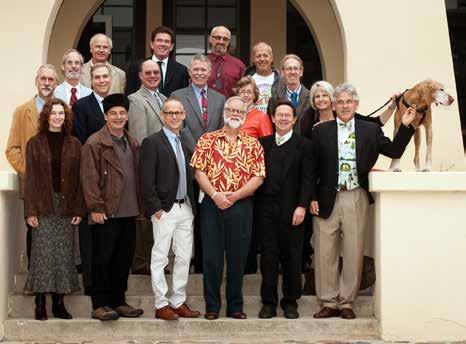
As our 50th reunion gift, our class is funding the Class of 1971 Visiting Artists Program, which allows the School to host artists in residence for days, weeks, or months at a time. The gift is designed to cover housing, meals, materials, and a stipend. We set an initial goal of $50,000, but have more than doubled that so far and we are not finished raising funds. The gift resonates particularly well with the opening of the new GATES building. (Kris Meisling)
We see our gift as a jumpstart that others can eventually get excited about so that this program lasts long beyond our initial funding. (Paul Gavin)
The idea sprang from the fact that there are many creative people in our class, and that our creativity was inspired and nurtured by the exposure we received to art through teachers, other students, and visiting artists while we were at Thacher. (Philip Murphy)

Toni Buffa, widow of our classmate Jerry Buffa and owner of Lemur Music (a string bass business), generously offered to donate a really nice string bass (an identified need) to the School on the occasion of our 50th Reunion last summer. In response, the class had a very active email discussion going in the run-up to the Reunion. Initial thoughts expanded in ever-widening circles until we arrived at funding a visiting artists program, broadly defined to include music, fine art, ceramics, woodworking, photography, film, writ ing, poetry, and dance. (Kris Meisling)
Many of us have pursued the arts in our lives, whether or not it was our actual career. We all agree that our spark of interest in the arts can be traced to a personally identifiable artistic “aha” moment, fostered by the example and influence of faculty and visiting artist mentors. We hope to lay the groundwork for students to have such moments, moments that can change a person forever! (Kris Meisling)
Pleasure, sensory involvement, learning activated by doing, and lively collaboration! For a lot of us who followed artistic paths, coming out of education was like jumping out of a plane, trying to figure it out on the fly. We also hope this program gives students a head start at that. (Paul Gavin)
Study with visiting artists can give young, aspiring artists a great sense of what’s involved in pursuing those fields in the real world—the financial challenges, the practical obstacles, the unseen opportunities, and so on. (Todd Oppenheimer)
My hope is that students get to experience the thrill of art, to adopt an openness to a full range of possibility, and a daring to explore the unknown that can make their lives fuller and more meaningful. (Ron Gee)
WHO MADE AN IMPRESSION ON YOU AS A STUDENT AT THACHER?
Our creativity was ignited and encouraged by the faculty: Michael Ehrhardt’s music enrichment, Edgardo Catalan’s art classes, Fred Lamb’s deep dives into history, and Fred Goode’s provocative classes on literature and writing. Thacher also provided many of us with our first exposure to woodworking, pottery, photography, theater, and film, not to mention workshops run by visiting artists such as Karl Malden and Jeff Corey on act ing, and live music by bands such as Booker T. & the M.G.’s! (Philip Murphy)
I would add Jim Danisch, who introduced me to ceramics. My exposure to him, to ceramics, and to art in general helped foster an appreciation that continues to this day. It was that exposure that prompted me to start college as an art major, and end up as an engineer with an emphasis in design. (Malcolm Plant)
My hope is that future generations of Thacher students will be inspired by what they learn from the Visiting Artists Program and that it enrich their lives. Whether they attribute this new knowledge to our gift is not important, but if a few of them realize that our class wanted to offer them some options they might not otherwise have been exposed to, that would be sweet indeed! (Philip Murphy)
Our class was a peaceful, loving, and experimental one. (Hans Peter Nielsen)
We passed through the School at a unique time when the world was turning upside down and all rules were temporarily suspended (sound familiar?). We developed our skills and values in the (somewhat) protected crucible that was The Thacher School. The arts were a big part of that value system for many of us. The arts are as relevant today as they were then, because they are part of a balanced diet that frees the mind to explore, imagine, and create. Computers only just barely existed. There was no internet. All that was yet to be imagined. What is yet to be imagined today? Eat your arts, kids! (Kris Meisling)
